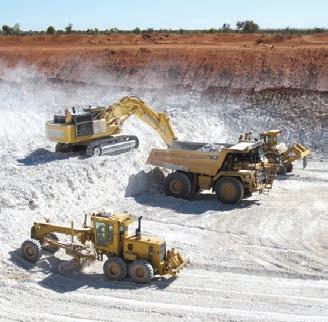








TOM PARKER
Tom.Parker@primecreative.com.au
The gold price has made itself at home up around $US2000 per ounce in 2023, amid growing economic uncertainty worldwide.
While this will please Australia’s gold producers, there are other pressing local issues that need to be addressed.
The 2023–24 budget has allocated $57.1 million to supporting international critical minerals partnerships, which complements the $2 billion Critical Minerals Facility established in 2021. Managed by Export Finance Australia (EFA), this facility provides funding for early-stage critical minerals projects.
But Australia’s broader critical minerals roadmap won’t become clear until Federal Resources Minister Madeleine King releases Australia’s critical minerals strategy for 2023.
It’s understood King’s paper will focus on Australia’s downstream processing opportunities to complement the country’s established mining credentials.
In the June–July edition of Australian Resources & Investment, we celebrate some of the critical minerals projects that will be key suppliers to a decarbonised future.
This includes Avenira, which is aiming to build one of only three LFP cathode manufacturing plants outside of China. This will be located in Darwin and take feed from Avenira’s Wonarah phosphate mining operation also located in the Northern Territory.
The LFP plant will produce a battery-grade cathode product for battery manufacturers worldwide – a product set to increase in demand in the years to come.
Other emerging critical minerals producers featured include Future Battery Minerals, which late last year made a significant lithium discovery at its Kangaroo Hills project in WA. The company also owns the promising Nevada lithium project in the US.
Recharge Metals recently acquired its Express lithium project in the James Bay region of Canada, which is becoming increasingly hot property as companies see the region’s significant hard-rock lithium potential.
Express is located near some of the world’s most promising lithium projects, including Allkem’s James Bay deposit and Cygnus Gold’s Pontax project.
Rare earths also have a key role to play in a decarbonised future. We spotlight four ASX-listed rare earths explorers that are worth keeping an eye on.
Elsewhere, we explore the journey of South32 since it was demerged from BHP in 2015, shine a light on some promising mining tech stocks and recap the recent RIU Sydney Resources Round-up in May, where 90 ASX-listed exploration companies showcased their achievements and project developments.
Happy reading.
CHIEF EXECUTIVE OFFICER
JOHN MURPHY
CHIEF OPERATING OFFICER CHRISTINE CLANCY
EDITOR
TOM PARKER
Email: tom.parker@primecreative.com.au
MANAGING EDITOR
PAUL HAYES
Tel: (03) 9690 8766
Email: paul.hayes@primecreative.com.au
CLIENT SUCCESS MANAGER
JUSTINE NARDONE
Tel: (03) 9690 8766
Email: justine.nardone@primecreative.com.au
SALES MANAGER JONATHAN DUCKETT

Mob: 0498 091 027
Email: jonathan.duckett@primecreative.com.au
BUSINESS DEVELOPMENT MANAGER DAVID GOLDBERG Mob: 0434 792 225 Email: david.goldberg@primecreative.com.au
SALES ADMINISTRATOR EMMA JAMES Tel: (02) 9439 7227 Mob: 0414 217 190 Email: emma.james@primecreative.com.au
DESIGN PRODUCTION MANAGER MICHELLE WESTON michelle.weston@primecreative.com.au
ART DIRECTOR BLAKE STOREY blake.storey@primecreative.com.au
GRAPHIC DESIGNERS KERRY PERT, LOUIS ROMERO
FRONT COVER
Past mining at Avenira’s Wonarah phosphate project in the Northern Territory.
Image: Avenira
SUBSCRIPTION RATES
Australia (surface mail) $120.00 (incl GST) Overseas A$149.00

For subscriptions enquiries please contact (03) 9690 8766 subscriptions@primecreative.com.au
PRIME CREATIVE MEDIA
379 Docklands DR, Docklands, VIC 3008, Australia www.primecreative.com.au
© Copyright Prime Creative Media, 2021
All rights reserved. No part of the publication may be reproduced or copied in any form or by any means without the written permission of the publisher.
Tom Parker EditorPRINTED BY MANARK PRINTING 28 Dingley Ave Dandenong VIC 3175 Ph: (03) 9794 8337 Published 12 issues a year
As gold enjoys a resurgence in 2023, it’s other golden opportunities that Australia must capitalise on.

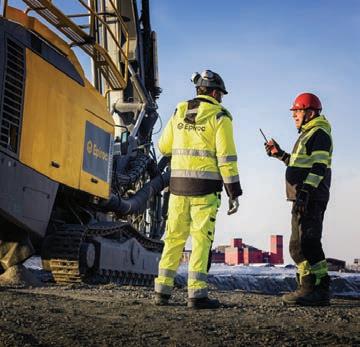




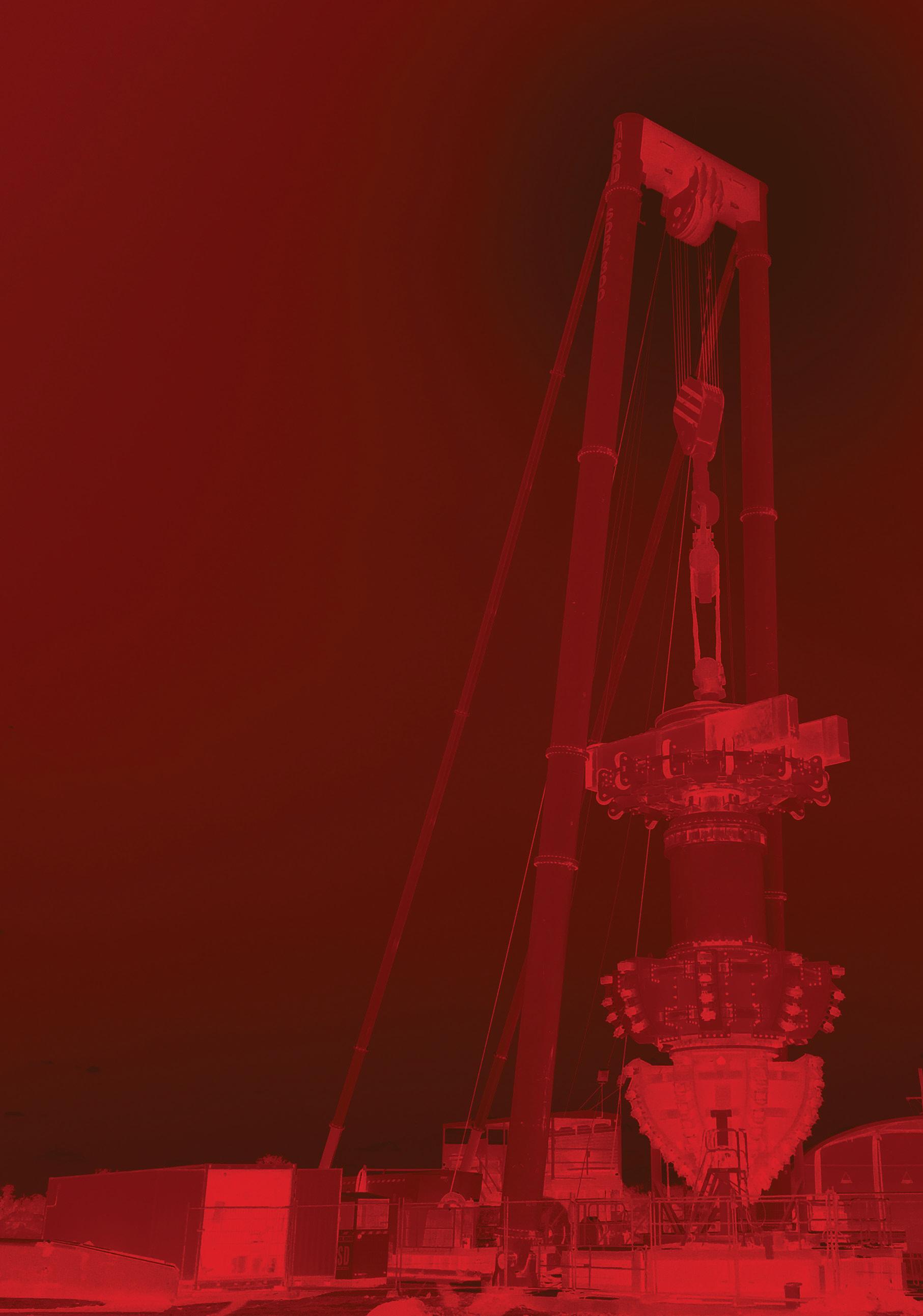
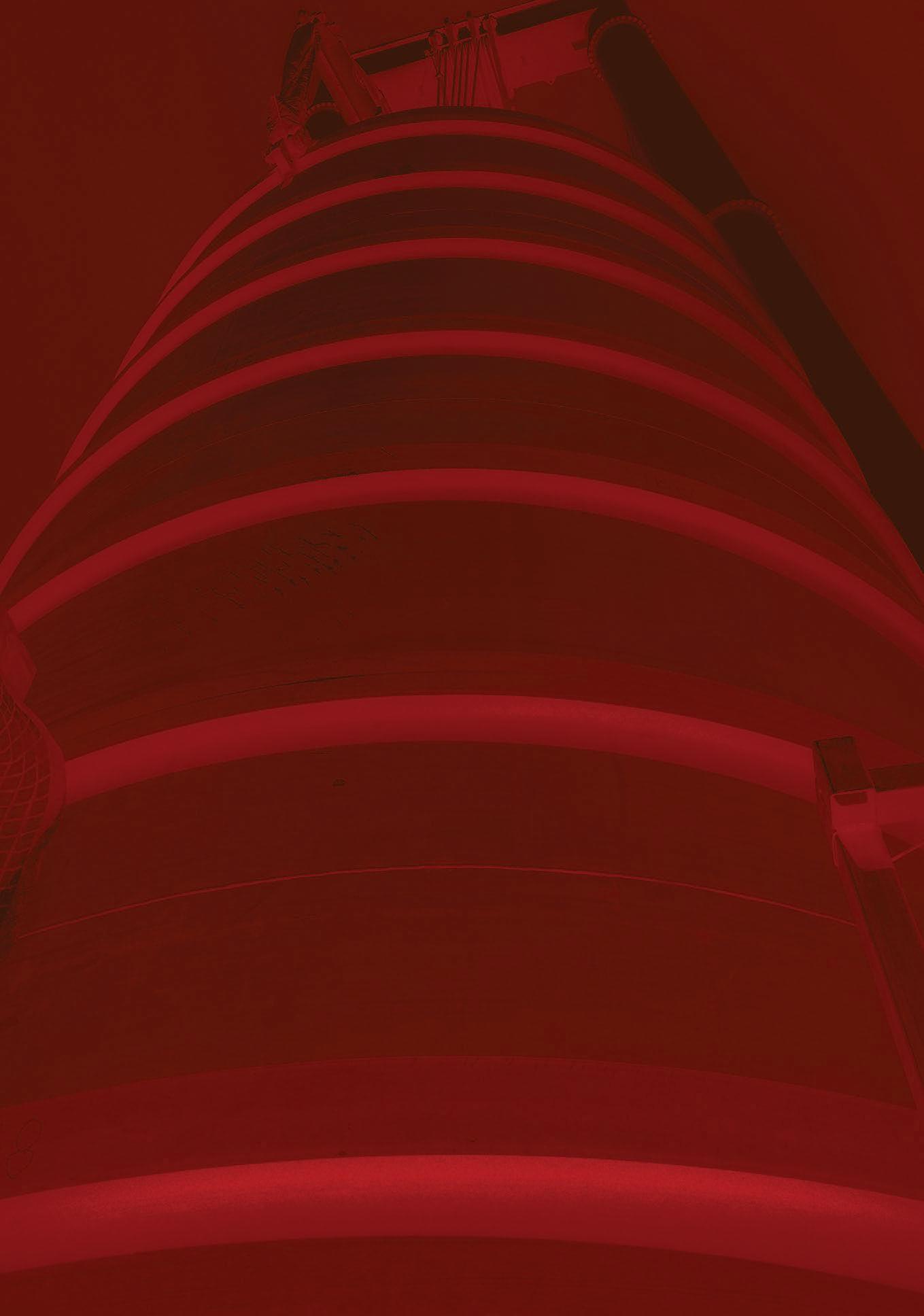



Mining technology is one of the great stories in Australian industry. From software to data, automation, and even space research, mining tech has a big future.
Woodside Energy Group’s work with NASA to develop robotic technology is an example. Woodside has one of eight NASA Robonaut 2 anthropomorphic systems in the world for testing.
Transferring technology from the resource sector to Australia’s space industry is highly innovative. Our mining and energy sectors are used to working in harsh environments (space is as harsh as it gets) and are world leaders in robotic technology in their field.
We can expect to see greater collaboration between the local mining and space sectors in the next few years as Australia leverages its strengths in resources to fast-track the development of a thriving local space industry, especially in Western Australia.
Woodside and Rio Tinto are already supporting the Australian Remote Operations in Space and Earth (AROSE) Trailblazer
Stage 1 through their terrestrial robotic and automation capabilities. Trailblazer will see Australia build, design, test and operate a lunar rover for NASA’s return to the Moon.
IMDEX and RPMGlobalAlthough fascinating, the work of Woodside, Rio Tinto and other large mining companies in space-related collaborations is small in the scheme of things – at least for investors. Nobody buys large mining stocks for their technology collaborations.
Australian investors who want space exposure typically buy giant offshore stocks; Lockheed Martin Corp, Boeing or Northrop Grumman, for example. Or they speculate
on a handful of ASX-listed micro-cap stocks developing space technologies.
Even so, the work of Australian mining companies in space technology highlights how much latent tech capability exists in the resource sector, as well as how technology within companies could be commercialised to create new shareholder wealth.
That trend is well underway, as mining services companies launch new brands

and capabilities around their technology businesses. No doubt they have watched the success of IMDEX and other specialist miningtech firms on the ASX.
Creating a standalone, branded tech division is the best way for some mining services companies to get greater market recognition for their technology and data capabilities.
ASX-listed mining services company Perenti has launched ‘idoba’, a promising new tech-driven service that leverages the company’s in-house technology and data expertise for its clients.
Boart Longyear, another ASX-listed mining services stock, this year launched Veracio as a wholly owned technology subsidiary. After years of problems, Boart Longyear has muchneeded momentum. Veracio has excellent technology through its TruScan product and long-term growth potential.
The next step is spinning out these and other businesses as standalone ventures and raising capital through an initial public offering (IPO) or demerger.
The time is right, assuming equity markets hold up this year. It’s likely there is latent demand for quality mining-tech companies from small-cap fund managers and other investors that want exposure to this fastgrowing sector.
Australia’s mining engineering, technology and services (METS) sector contributes $92 billion to the nation’s economy, according to METS Ignited. The sector’s projected growth is expected to add another $50 billion to the economy by 2030.
The METS sector has averaged annual growth of 7 per cent, and as Australia’s economic growth slows this year (and possibly even flirts with recession if interest rates keep rising), the sector stands out for investors.
METS, of course, is much broader than technology. But the sector’s size, success and projected growth raise important questions: Why are there so few specialist mining-tech stocks listed on the ASX? How can investors get exposure to this sector?

Here are two ways to play the mining-tech trend on the ASX.
One of this market’s great small-cap companies, Perth-based IMDEX is a key choice for local investors seeking specialist miningtech exposure.
IMDEX helps drilling contractors find, define and mine orebodies. Real-time data enables miners to make faster, better decisions.
IMDEX shares tumbled in early 2020 as the market reacted to COVID-19. Investors feared commodity prices would sink and mining activity would slow. IMDEX relies heavily on exploration spending, which was expected to stall during COVID-19.

But from its 2020 low of around $0.80, IMDEX rallied to almost $3 in early 2021 as the market realised it had overreacted to COVID19’s effect on the METS sector.
IMDEX has since eased to $2.08 (in early May), in line with broader weakness in smallcap stocks. Small-cap investors should keep an eye on IMDEX at that level.
IMDEX has four attractions for investors.
Tony Featherstone is a former managing editor of BRW, Shares and Personal Investor magazines. The information in this article should not be considered personal advice. It has been prepared without considering your objectives, financial situation or needs. Before acting on information in this article consider its appropriateness and accuracy, regarding your objectives, financial situation and needs. Do further research of your own and/or seek personal financial advice from a licensed adviser before making any financial or investment decisions based on this article. All prices and analysis at May 9.
Firstly, it’s leveraged to rising mining activity. If, like me, you believe the commodity supercycle is still in its early stages (largely due to supply constraints), companies leveraged to higher mining activity are appealing.
Secondly, IMDEX is transforming its business model. More of its revenue is coming from higher-margin, recurring tech services, and less from its drilling consumables market – a trend that should continue.
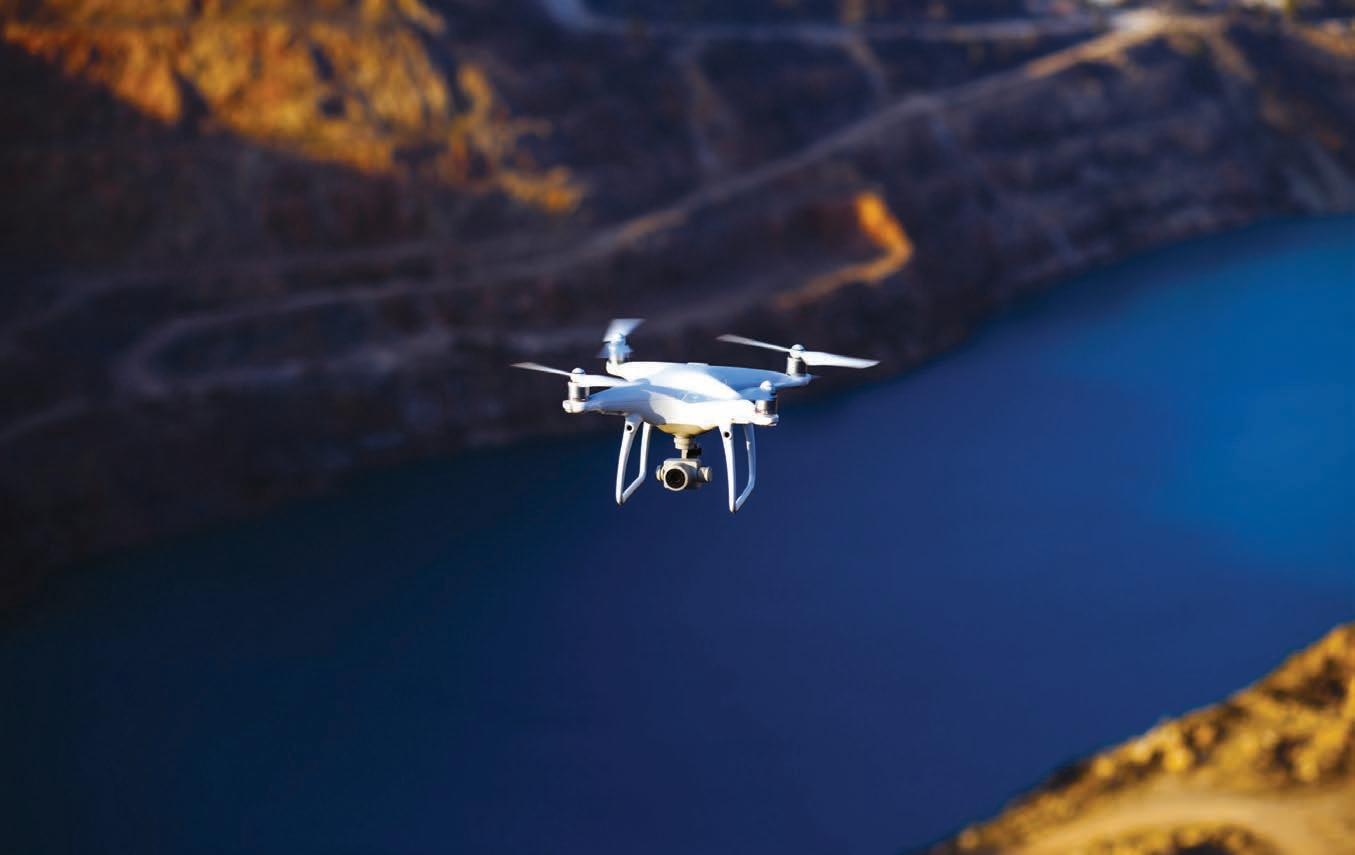
Thirdly, IMDEX can broaden its ‘touchpoints’ in the mining value chain. The company’s BLAST-DOG blast-hole drilling technology has good potential.
Although it’s early days for BLAST-DOG, the technology could increase IMDEX’s exposure to the production phase of mining, and gradually reduce its reliance on the more cyclical exploration phase. If successful, that could help re-rerate IMDEX by attracting a higher valuation multiple.
The fourth attraction is acquisitions. March saw IMDEX complete its acquisition of Devico AS for $324 million. The Norwegian company is a global leader in drill-site technology, including for sensor and directional drilling.
RPMGlobal is the other main choice in smallcap mining tech stocks on the ASX.
The Brisbane-based company provides software for mine scheduling, budgeting, simulations and asset management, and trains employees on how to use the software. Its advisory business consults on the technical and economic assessment of mines.
Established more than 50 years ago, RPMGlobal has 24 offices overseas and a global client base, with some of the world’s largest mining companies using its software.
RPMGlobal used its March 2023 half-year review to reaffirm its EBITDA guidance of $14.2 million for FY23. The company also confirmed total revenue for FY23 would be $96.4 million, from earlier guidance of $101 million.
A hot labour market has made it harder for RPMGlobal to source employees, particularly in its advisory business, and greater use of contractors has put pressure on costs.
These short-term headwinds have seen RPMGlobal fall from a 52-week high of $1.95 in November last year to $1.36 in early May 2023. Like IMDEX, RPMGlobal is well down this year.

In its half-year review, RPMGlobal said it was “excited about the magnitude of opportunities entering the company’s software pipeline”. Progress in the Indonesia mining-tech market and southern Asia were other highlights.
RPMGlobal has long-term growth potential in the booming environmental, social and governance (ESG) advisory market in mining. Broadening its revenue base in clean-energy mineral projects – and acquisitions – is another source of growth.

Capitalised at $309 million, RPMGlobal does not suit conservative income investors; however, the company has more substance than many similarly-sized tech companies on the ASX – and a global footprint in a growth market.
Software-as-a-service is a great business model when it works. Mission-critical software in mine operations has high switching costs and provides recurring, higher-margin revenue. Just over a third of RPMGlobal’s revenue is recurring.
The company is well-positioned for strong mining activity in the next few years – and for greater uptake of mining-tech services, particularly mobile solutions – but you wouldn’t know that by looking at RPMGlobal’s share price this year.


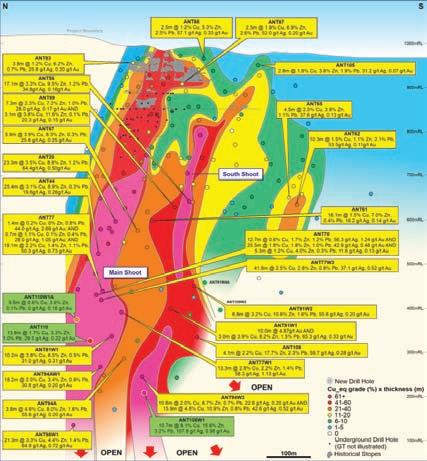
Growing concern about climate change has seen global sentiment swing away from fossil fuels such as oil, gas and coal, but while global energy consumption is increasing each year, alternatives cannot yet supply enough to meet industry and population demands.
This means we will still need to rely on fossil fuels over the short-to-medium term. In the case of oil, we investigate the effect its price has on an explorer, producer, distributor, and a user.
The oil price has walked a volatile path in recent years, which can, for the most part, be attributed to global unrest.
From the mid-1970s until mid-2004, the per-barrel price reached highs of around $US40 and lows just above $US10; however, the price broke away from this broad phase in the last quarter of 2004 and began a surge that would see the price reach over $US145 by July 2008.
The oil price fell to $US31 in December of 2008, before rebounding strongly to produce a rising pause action from $US72 in 2009 to $US86 in May 2010 before launching higher to halt at a double deflection point at $US113 in April–May 2011.
The $US100–110 zone remained a barrier through to June 2014, with a
final deflection precipitating a rapid price decline into the previous base, this time at a lower level around $US26 in February 2016.
The oil price was supported through 2016 and 2017 and rose to locate a barrier around $US75 halting the price between June and October 2018. This became another deflection point, with the price plunging to reach a low around $US9 in 2020.
A pivotal turning point was produced and oil rose dramatically to pause in the later stages of 2020 at around $US40 before continuing its upward path to reach a secondary peak at $US125 in March 2022.


Divergent momentum caused the price to fall and seek trend support at $US66 in March this year. It has now become wedged between that support and resistance in the $US83–85 area.
It is likely that more churning may occur in the $US65–85 range, with the risk of breaking lower diminishing over time. In such a case, back-up support would be in the $US55–60 zone.
There is also potential for the oil price to break higher through $US85 to head towards $US95–100.
Following its merger with BHP Petroleum, Woodside Energy Group is the largest Australian independent oil and gas exploration and production company.
Woodside’s Australian oil assets include the Ngujima-Yin floating production storage and offloading (FPSO) oil production
facility located over the Vincent oil field in Western Australia; the Okha FPSO vessel, an oil production facility moored to a riser turret located north-west of Dampier, WA; and the Pyrenees project, which consists of six conventional oil fields in the Carnarvon Basin, north-west of Exmouth, WA.
The Woodside share price was hurt by the oil sell-off in early 2020, producing a pivotal reversal in March that led to a volatile upward trend which has carried the

price from its low point around $15 to reach its previous barrier zone at $39–40. The price stopped at the barrier in November 2022 and oscillated down to test support in the $28–31 area.
These price oscillations are likely to continue between support and resistance in much the same manner as the oil price, with a breakaway through $40 triggering another stage higher. The risk would be a drop below $25.
Australia’s leader in transport fuels, Ampol (previously Caltex Australia), supplies the country’s largest branded petrol and convenience network, as well as refining, importing, and marketing fuels and lubricants.
The company supplies fuel to diverse markets across Australia, including defence, mining, transport, marine, agriculture, aviation, and other commercial sectors.
The Ampol share price experienced heightened volatility in 2018, producing an impulse move during the later part of 2019 which saw the price catapult to test resistance in the $35–37 area, where it failed.

The Ampol price fell dramatically in early 2020 in line with the oil price, finding a pivot at $18.32 into a new upward path. This allowed the price to rotate higher and retest its former barrier, with a spike up to $37.55 in June 2022.
From here the price swung lower within the trend towards support around $26 with the action re-engaging former guidelines to allow more fluctuations between $26 and $37, with a breakaway through $39 prompting the next major upswing.
Lindsay Australia’s major activities are road transport, logistics, warehousing services, and specialist services to rural suppliers, with an emphasis on the horticultural industry.
Since its establishment as Lindsay Brothers Transport in 1953, Lindsay Transport has become one of Australia’s largest transport companies, delivering more than two million tonnes of freight to over 3200 customers. The company’s diversity seems to have limited the impact of oil prices.
A fluctuating share price for more than 20 years built a large price base for Lindsay Australia.
Completing the base in August 2022, the price hurtled higher along an exponential curve, exceeding initial expectations to around $1.10. The price stretched to $1.38 on May 1 this year and paused in overbought conditions.
The price has support at $1.10–1.15 and then, more importantly, in the $0.80–0.90 area. Beyond the pause phase, the stock retains the ability from the base to retest the $1.38 level and continue higher through $2.
ARI shines a light on three ASX-listed rare earths explorers and highlights the emergence of the ionic clay-hosted rare earths deposit.
While China has long dominated the world’s rare earths production, processing and manufacturing of rare earths magnets, the market is changing and other countries are putting themselves in focus.
The hallmark of a successful mining company is the strength of its relationships, and emerging rare earths jurisdictions are looking beyond China when commercialising their product.
Lynas Rare Earths – Australia’s only rare earths producer – has shared a longstanding partnership with Japan, with the latter a trusted buyer and financier of the Perthbased miner.
What started in 2011 with $US250 million of debt and equity financing from Japan Australia Rare Earths B.V. (JARE), was reinforced in March when JARE made a $200 million investment in Lynas and forewent $US11.5 million of debt owed by Lynas.
As part of the agreement, Lynas will update its existing supply rights to reflect continued growth in the Japanese rare earths market, prioritising Japan in its rare earth shipments.
Two other near-term Australian rare earths producers, Hastings Technology Metals and Arafura Rare Earths, have established ties with European, US, Canadian and Korean partners.
This includes partnerships with automakers such as Hyundai and Kia, renewable energy players Siemens Gamesa and General Electric (GE), chemical companies, trading houses and downstream processors, carving out new commercial pathways for the companies and its peers to follow.
Three emerging ASX-listed companies aspiring to be rare earths producers include Meteoric Resources, Larvotto Resources and Eastern Metals, each of which have made significant progress in the last 12 months.
We take a closer look at their attributes and potential.
Meteoric’s stock soared from $0.020 per share in December 2022 to as high as $0.18 per share in late-April following its acquisition, expansion and delineation of the Caldeira ionic clay rare earths project in the Minas Gerais state of Brazil.

The company announced its maiden mineral resource for Caldeira in early May, demonstrating what it believes is the world’s highest-grade ionic clay rare earths deposit.
“Until today, the highest known ionic clay deposit in the world was a deposit called Penco in Chile,” Meteoric executive chair Andrew Tunks told Australian Resources & Investment
“Penco has a resource of about 20 million tonnes (measured and indicated) and a grade of about 2200ppm (parts per million). Our announcement was significant because one, Caldeira is 400ppm higher – about 20 per cent more than their grade – and its 400 million tonnes, it’s nearly half a billion tonnes.
“Typically, you get small high grade, or large low grade, so it’s a really rare combination for Caldeira to be both large and the highest grade.”
Caldeira’s maiden mineral resource was derived from 1379 drill holes. The average drill depth in the resource is 6.9m and 85 per cent of all holes generated total rare earth oxide (TREO) grades above 1000ppm.
With Caldeira’s maiden mineral resource in the inferred category, Meteoric will now focus on upgrading the project.

“Before you can do any studies, for example a feasibility study, you need to upgrade the understanding of your resource, and that typically means closing up the drill spacing,” Tunks said.
“To get from inferred to indicated, and then from indicated to measured resource categories, we need to complete approximately 100,000 metres of drilling, so there’s a lot of drilling and we’ll be commencing that program as soon as we can.
“In the interim, we will continue and expand the current diamond drilling to collect additional samples for metallurgical testwork. There has been preliminary metallurgical testwork done, it’s quite positive, but we need a significantly larger metallurgical program testing for variation across the project and with depth.
“So really the first year is going to be about drilling, drilling, drilling, and improving our resource categories and at the same time, growing our team. We’ve just appointed a new CEO, Nick Holthouse, who has rare earths experience as COO of Hastings Technology Metals.”
Outside of China and Myanmar, rare earths mining has typically taken place in hard-rock environments. This is how Lynas has mined its rare earths since entering production in 2011.
Meteoric has a unique opportunity in that its rare earths are hosted in ionic clays, with Tunks suggesting that “nature has already done the work for us”.
“Like Lynas, clay-hosted rare earths were originally hosted in hard rock, but through the action of time and oxygen they have weathered at the surface and all the granite has now turned into clay,” he said.
“During that weathering process, the minerals that hold the rare earths have been broken down, and the rare earths have been released into the clay.”
Hard-rock rare earths deposits are typically much higher grade than their clay-hosted peers, but processing this ore is typically more onerous. While clayhosted processing practices are still early stage, with further research required to understand the metallurgy, there is evidence to suggest this method is less costand carbon-intensive.
Another ASX-listed company with a potential clay-hosted rare earths project at its disposal is Larvotto Resources.

In April, the company announced it had intersected bonanza-grade rare earths at the Merivale South prospect within its Eyre project in WA.
The company’s share price surged from $0.135 per share to as high as $0.33 per share after aircore (AC) drilling at Merivale South intersected up to 1.26 per cent TREO. This highlighted the potential of a 3km-long TREO anomaly that sits within a broader 8km-long anomaly.
Larvotto completed two drill lines 500m apart along the 3km-long anomaly, with the zone remaining open in all directions, particularly to the west.
Maiden composites led to the discovery of 3466ppm TREO over 6m, before Larvotto undertook 1m resamples and discovered results as high as 1.26 per cent TREO (12,611ppm).
When asked if the assay results surprised him, Larvotto managing director Ron Heeks said he was always optimistic about the geochemical indications.
“We had a very good geochem anomaly and we had a coincident thorium radiometric anomaly at Merivale South, which meant given the area hadn’t had a single drill hole in it, we needed to test it and see what the anomaly meant,” Heeks told Australian Resources & Investment
“It came back very strong, and I’d like to be able to talk more about the skill that went into it, but it’s fair to say we didn’t overthink it.
“I was always positive on the prospect because of the level of the anomaly, and I was
looking at a lot of companies around us who were following up anomalies at 100–200ppm, and we were up around 700–800ppm. So that was pretty interesting.”
Heeks said while early exploration indicated the rare earths at Merivale South are hosted in ionic clays, Larvotto will need to conduct metallurgical testing to determine the optimal process route.
Once Larvotto has an understanding of the processing options, the company will aggressively drill and explore the tenement to further understand the scale and nature of the rare earths. And with more than 35 years’ experience in building mines, the project is then rapidly falling into Heeks’ sweet spot.
“If they are clay-hosted rare earths, which I’d like to think they are, then we’ll immediately get into a pretty serious drill program to determine what we’ve got, and at the same time, commence very active metallurgy to determine what we have to do to extract the rare earths.
“I think these deposits can be drilled out very quickly, and then it’s about what you have to do with the metallurgy. Is it going to be simple or not?
“You also need to think about how many consumables you are going to use. Water won’t be a problem for us, there should be no significant issues environmentally and with native title.
“But above all, it gets down to what the metallurgy is going to tell you. That’s the beginning and end of the problem.”
Rare earths are just one set of minerals Larvotto is exploring at its Eyre project, with a multi-commodity focus also showing potential for lithium, nickel, gold and platinum group elements (PGEs).
Lithium, in particular, has attracted lender attention with Larvotto receiving a $3.4 million cornerstone investment from Canadian institutional fund Lithium Royalty Corp. and Waratah Capital in October last year.
This came following a successful lithium geochemistry campaign at Eyre’s Merivale prospect that defined a lithium anomaly across 4km with a high-grade centre over 1km. The maximum grade identified was 126ppm lithium.
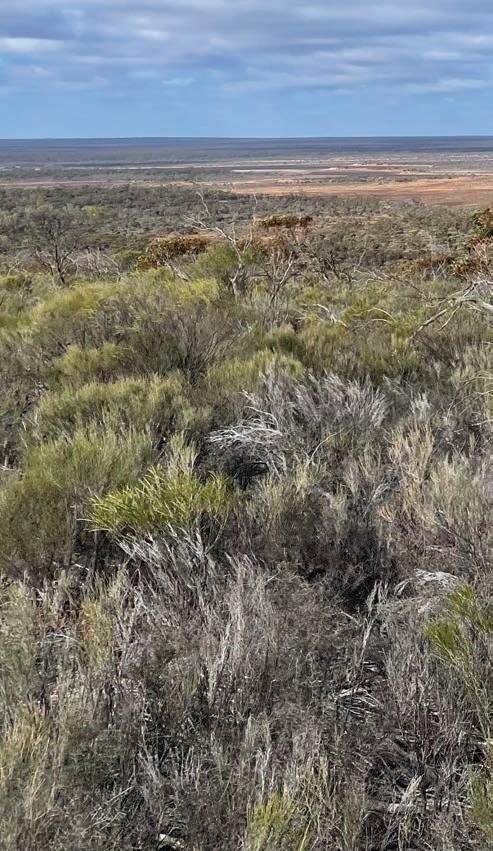
In April this year, Larvotto announced an AC drill program had identified at least nine pegmatites associated with the lithium anomaly. A broad anomaly containing more than 1000ppm nickel was also identified. This could span more than 1km in length.
Eastern Metals is exploring a suite of NSW and NT base and precious metals projects, and as the Browns Reef and Home of Bullion deposits have shown promise, a new rare earths prospect has also emerged.
The Tara project consists of the Currawalla mine which had been historically explored for base and precious metals. When Eastern Metals carried out portable XRF (pXRF) testing at Tara it didn’t identify base or precious metals but instead discovered high-grade rare earths.
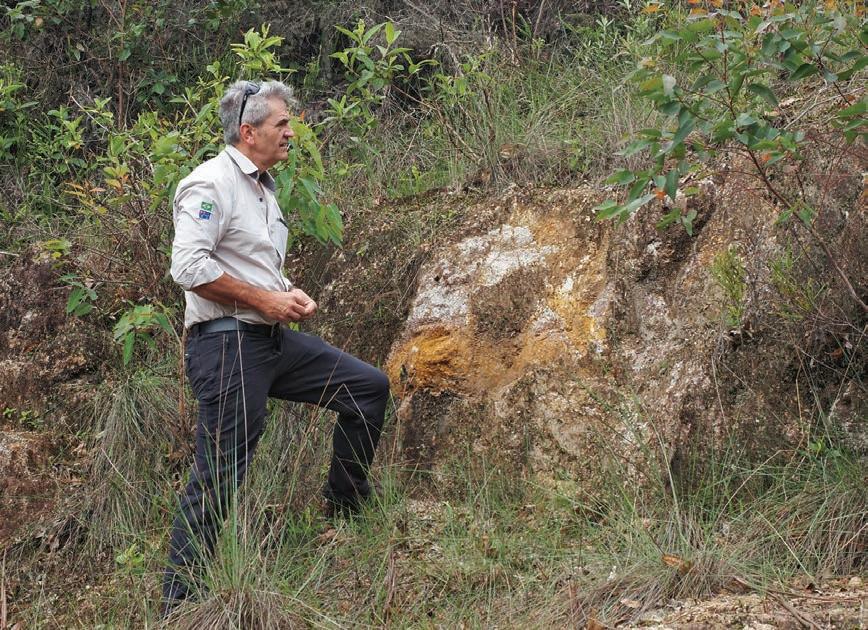
Samples from high pXRF readings were submitted for laboratory analysis and returned assays up to 3.38 per cent TREO.
Eastern Metals executive chair Bob Duffin said these readings were strong enough to indicate the company could be onto a significant rare earths discovery.
“The Tara project is in an environment where there are no rare earth deposits,” Duffin told Australian Resources & Investment. “The trend from Currawalla goes off our tenement onto vacant ground both to the south and the east.
“We lodged an exploration licence application to cover the extensions of that structure and that application has been recommended for grant, so we’ve now got quite a significant tenement position south of Cobar in an area where we’ve got rare earths readings that have been checked and reproduced by conventional assays.

“We’re not simply relying on the portable XRF results, so that’s looking pretty positive.”
To follow up its rare earths findings, Eastern Metals will return to Tara and extend its mapping of the prospect.
“There is a coincident aeromagnetic anomaly associated with the project’s old workings, which gives us comfort that there will be good tonnage potential to whatever it is that’s causing this anomaly and the body of rare earth mineralisation,” Duffin said.
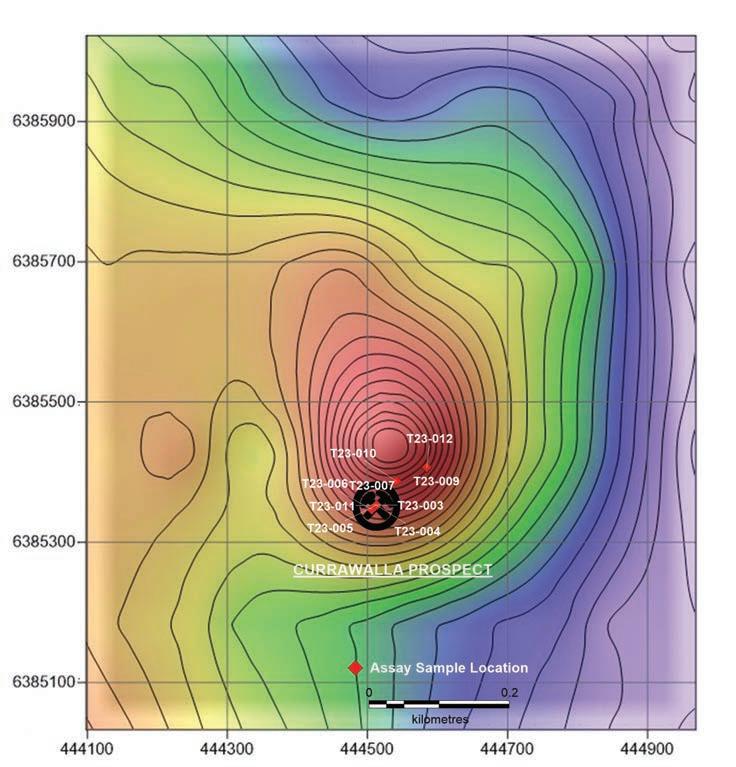
“So, we’re pretty excited about this. What I’ve learnt in my career is nothing beats high grade, no matter what the commodity, and these grades are very high.”
Duffin said that when Eastern Metals listed on the ASX and launched its IPO (initial public offering) in October 2021, it was very much focused on delineating its Browns Reef and Home of Bullion deposits.
But these rare earths findings have changed the company priorities, with Eastern Metals to focus on Tara for at least the next few months.
Duffin said the company would carry out a three-phase exploration program at Tara, which starts at Currawalla.
“Firstly, we will concentrate on Currawalla and its immediate environment because that’s where we got the high-grade rare earths mineralisation,” he said.
“The second phase of our work program is to follow up some high-quality aeromagnetic data available for much of the new ground that we’ve applied and will be granted – we’ve been advised of that by the regulator.
“The Currawalla mine is associated with an aeromagnetic anomaly, and there are a number of other similar aeromagnetic anomalies within the granite terrain in our Tara licence, and our new license which we’re going to call Black Range. So, we will follow up these and do that in parallel with our work at Currawalla.
“The third leg of our program will see us extend that exploration coverage elsewhere into the new Black Range license area.”
Duffin said Eastern Metals would be drilling at Currawalla in the near future.
The ASX might have a few notable rare earths stayers, but there’s also a host of new rare earths players worth monitoring. This includes Meteoric, Larvotto and Eastern Metals, three companies that have made significant ground over the last 12 months.
VHM holds one of the largest rare earths inventories in Australia. ARI chatted to VHM managing director Graham Howard about how the Goschen project is coming along.
VHM is rapidly building a new industry in the emerging mining jurisdiction of Victoria, with a suite of adjacent projects set to form multiple hubs as part of a rare earth and mineral sands district.
The company had already defined a significant rare earths deposit at its Goschen project but has since lifted the lid on two additional nearby projects that will further expand its mining future.
VHM announced its maiden inferred mineral resource estimate for the Cannie project in mid-May, containing 192 million tonnes (Mt) at 3.1 per cent total heavy mineral (THM) grade. This boosts the company’s total resource inventory by 30 per cent to 820Mt.
Cannie has added 176,000 tonnes of rare earths, 1.4Mt of zircon, 0.9Mt of rutile and 1.4Mt of leucoxene. In combination with the Goschen project, the total mineral inventory now boasts 5.1Mt of total zircon, 2.7Mt of total rutile and 2.9Mt of total leucoxene.
The higher-grade nature of the Cannie resource has also increased VHM’s total rare earths inventory from 413,000 tonnes to 589,000 tonnes.
Cannie, located only 13km south of Goschen, demonstrated its high-grade potential early in the drilling program, with the first 17 drill holes averaging 4.9 per cent THM across an average width of 2.7m.

VHM used 38 drill holes for the Cannie inferred resource estimate, with results pending from a further 104 holes at the project. These additional drill holes will increase confidence in the resource and potentially expand it further.
“We’ve intersected some pretty special grades at Cannie, which are very high in TREO (total rare earth oxide) and very high in rutile and leucoxene, which is a slightly different composition to what we discovered at Goschen,” VHM managing director Graham Howard told Australian Resources & Investment.
“We’re seeing a different titania mineral assemblage at Cannie, and we’re also getting some pretty good zircon grades there too.”
VHM recently released a refreshed Goschen definitive feasibility study (DFS), which demonstrates a project with a net-present value (NPV) of approximately $1.5 billion and a 44 per cent internal rate of return (IRR).
“The DFS is based on a process facility that has only five-million-tonnes-per-annum of throughput using conventional mining technology and shallow pits down to 30 metres in sand at Goschen,” Howard said. “And we’re backfilling those pits straight away with sand from the process plant.”
The Goschen project is designed to be progressively rehabilitated at it produces, meaning there are no surface tailings, no permanent waste dumps and no visual scars.
This lends to stronger environmental, social and governance (ESG) credentials and reduced legacy issues down the track.
Goschen is also unique in that its multicommodity profile means VHM can benefit from multiple revenue streams to support its bottom line.
“When we look at the overall process, the two commodity streams are the rare earths, and the zircon and titania,” Howard said.
“The zircon and titania are effectively paying for the mining, processing and logistics costs of the project. We’re able to produce rare earths at exceptionally low operating costs compared to our peers, and that sets this project apart.”
Howard and his VHM team have been spending plenty of time on the road to understand the company’s unique marketplace, while gathering insights into the projected rare earths shortfall in the years to come.
“The world is very focused on supply issues for rare earths in the timeframe of 2025–26, just as our Goschen flagship project is
being commissioned and coming on stream,” Howard said. “So we’re entering a perfect time to be producing zircon and titania and most importantly, rare earths, which will generate around 75 per cent of our revenue.

“We’ve got the big four which are needed for the permanent magnets that are driving the electrification of vehicles and wind turbines as part of global decarbonisation.”
The big four are the rare earth elements, neodymium, praseodymium, dysprosium, and terbium, each of which are listed on the US critical minerals list.
Time away has also enabled VHM to continue offtake discussions with potential partners.
VHM already has the backing of leading Chinese rare earths mining and processing company Shenghe Resources, with which it has signed a memorandum of understanding (MOU) for a take-or-pay offtake agreement over an initial three-year term.
If converted to a binding agreement, this would enable Shenghe to purchase 60 per cent of the Goschen product, whether this is the zircon-titania heavy mineral concentrate or the rare earth mineral concentrate for the first three years of production.
Further processing of the concentrate through a hydrometallurgical (hydromet) circuit will produce a rare earth mineral carbonate, which provides VHM offtake flexibility.
“The hydromet circuit should be switched on within six months of the commissioning of the first phase of the plant,” Howard said. “This will effectively give us a new, higher value product that is not yet committed to any party.
“While we were overseas as part of an Austrade delegation, discussions have shown
there is a great deal of global interest in this higher-value product.
“This changes the dynamics a bit. So what we’re doing is working with all our parties to understand their requirements. What is abundantly clear with the geology and the Cannie announcement is we have a series of major projects here.
“I call them project hubs, which can be brought online as corporations or nations require.”
The company is also in discussions with European, North American, South-East Asian and Japanese corporations about potential offtake agreements.
Howard said VHM’s permitting process is advancing on-schedule, with the company finalising adequacy review of the Environmental Effects Statement (EES). This will be assessed by the Minister for Planning who will then authorise the document for public exhibition.
This paves the way for ministerial approval to build the mine, which VHM hopes to achieve by the end of 2023.
Howard said VHM has put a lot of effort into front-ending the approvals process so that there are no hiccups down the track when Goschen is constructed and brought into production.
VHM is also establishing its social licence to operate, underpinned by recent MOUs signed with the Swan Hill and Gannawarra councils.
“The agreements with the local shires demonstrate the broad community support we have been receiving for this project,” Howard said. “Since 2018, all of the studies we’ve completed indicate that the Goschen project is low impact compared to similar projects.”
The construction and operation of the Goschen project is also expected to add more than $2 billion to the Loddon-Mallee economy and an estimated $1.3 billion to the Victorian economy across its planned 20+ year mine life.
VHM was already onto something significant with its Goschen project, and the addition of the prospective Cannie and Nowie projects has confirmed the emergence of a new critical minerals province in northwest Victoria.
And with detailed engineering work underway at Goschen, continued exploration at Cannie and Nowie, as well as ongoing approvals and offtake discussions, investors can expect a strong newsflow from VHM across the next 12 months.
Every new announcement will further derisk what is destined to be a near-term rare earth and mineral sands operation to support the world’s decarbonisation.
ARI was on hand for a recent fireside chat with South32 CEO Graham Kerr, who reflected on how the major mining company has gotten to where it is today.
South32, which was demerged from BHP in 2015, describes itself as a “globally diversified mining and metals company” and is now transitioning to become a key manganese producer in the US.
The company’s future is certainly bright, but chief executive officer Graham Kerr admitted South32 initially had a portfolio that could only be described as a “mixed bag”.
“Within BHP, there are lots of assets that have a lot of opportunity for development in the future that weren’t quite getting the love or systems they needed,” he said during a fireside chat at a recent Melbourne Mining Club luncheon.
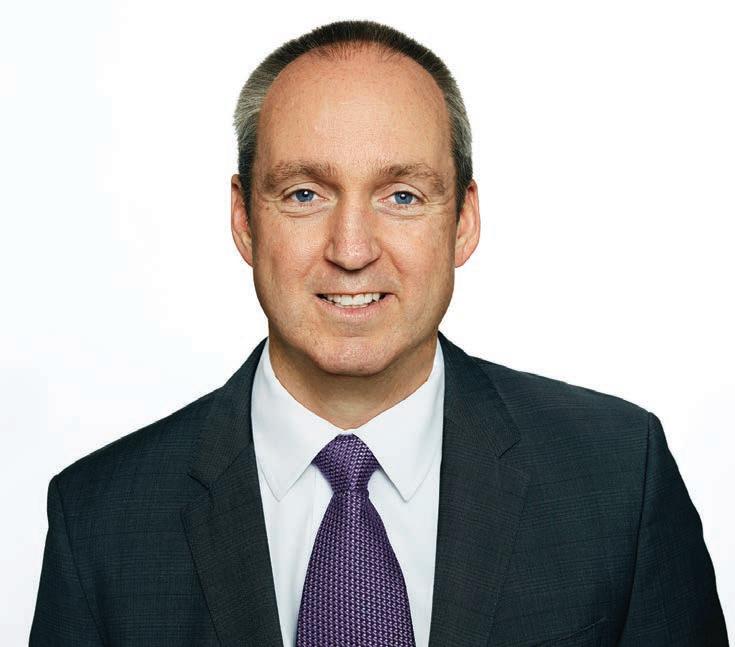
“For me, the demerger was a great opportunity for both companies to be better than what they were together. (And) both companies have continued to change and evolve.”
South32’s commodity mix included energy coal, metallurgical coal and manganese, with nickel, lead, silver, zinc and aluminium also featuring in the portfolio.
It was from this position that Kerr and his colleagues set about finding potential in base metals.
Eight years on, the company’s portfolio has changed a lot since Kerr sat in the first South32 meeting with then-chairman David Crawford.
“We certainly had a belief for what assets belonged in South32 and what assets didn’t belong in South32,” Kerr said.
“If you take a step back, what we did actually recognise is if you look at the world today, with a lot of the M&A activity that occurred in the prior two decades, most of the mid-tier mining companies had disappeared.
“So part of the advantage of South32 was it’s a mid-tier-sized mining company … and for a mid-tier company, you only need one or two great discoveries or one or two great acquisitions and you can fundamentally change the nature of the group and create a lot of value for your stakeholders.
“It was clear some commodities had a more attractive future than others. We talked about wanting copper and we did talk about expanding our zinc and nickel presence, and those commodities in particular have been far more attractive in a world of decarbonisation.”
Those discussions laid the foundations for South32 as the company transitioned its portfolio and projects to be largely based in the Americas.
The US Government’s recent endorsement of the Hermosa project, located in southern Arizona, has meant South32 could become the country’s primary manganese producer.
Hermosa, which has the potential to produce manganese and zinc, has been added to the FAST-41 project list, which is designed to create better processes for complex critical infrastructure projects. Hermosa is one of the first mining projects
to join the program, which could assist it with obtaining federal permits for the development of South32’s Taylor and Clark deposits, both of which are located within the Hermosa project.
According to Kerr, once the Taylor and Clark projects are up and running, South32’s portfolio composition will rise to 85 per cent base metals, with majority of the company’s value in the Americas.
“The inclusion of Hermosa as the first mining project added to the FAST-41 process is an important milestone that recognises the project’s potential to strengthen the domestic supply of critical minerals in the US,” Kerr said. “The project presents a significant opportunity to sustainably produce commodities critical to a low-carbon future.”
South32 is advancing a Clark feasibility study, with a pilot plant recently commencing production. A feasibility study for the Taylor
deposit is expected to be completed later this year.
A key part of the project will see South32 engage with local communities to ensure the project has flow-on benefits to the surrounding area.
“Becoming a covered FAST-41 project will make the rigorous federal environmental review and permitting process for this project more transparent, predictable and inclusive for all stakeholders,” South32 Hermosa president Pat Risner said.
“We are committed to working closely with the US Forest Service, cooperating agencies, Native American tribes, and local stakeholders in Santa Cruz County in Arizona to develop this project in a way that benefits the community, minimises impact on the environment, and creates opportunities across the region.”
Alongside its US assets, South32 also has growth options in South America, including a bright future for its Sierra Gorda copper mine in Chile.
South32 purchased a 45 per cent stake in Sierra Gorda in February 2022, but while the company has long been keen to boost its copper presence, it took time to warm up to Sierra Gorda.
“How many people in the room have watched Shrek with their kids before?” Kerr asked the Melbourne Mining Club audience.
“There’s a bit where the donkey is talking to Shrek and says, ‘Shrek, you’re like an onion. You’ve got to take the layers off the onion to understand what you’ve actually got’.
“When the business development team first brought Sierra Gorda to me, I was probably like most other people in the market and thought, ‘This is a challenged asset. It’s got a history of having a challenging ramp-up and there’s very little information in the marketplace about it’.
“Every challenge we gave to the business development team to take a layer off that onion, they came back with more positive results.
“In the end, we became convinced that it was the right thing to do.
“We’ve had it for about a year now and we’re really happy with the acquisition. We’ve been really surprised by the upside in the asset and the quality of the people.”
Alongside its Chile presence, South32 is also involved in earn-in agreements with two emerging copper exploration projects in Argentina – Chita Valley and Don Julio.
South32 recently exercised its earn-in right to acquire a 50.1 per cent interest in the Chita Valley project following a threeyear exploration partnership with Minsud Resources Corp.
The major miner signed an earn-in agreement with Sable Resources to explore Don Julio in 2021, with drilling advancing at the project.
Kerr said Argentina could be a copper jurisdiction to keep an eye on in years to come.

“Argentina’s become an interesting location,” he said.
“When we first started doing some work there, we were probably the only ones. You’ve got BHP there, you’ve got Barrick there, you’ve Glencore there – everyone’s sort of pouring money into that jurisdiction at the moment.
“If you look at where it is, it’s on the other side of the Chile mountains where basically all the copper is.
“So I think that’s an area that’s going to develop pretty quickly.”
Whether it’s the Hermosa project in the US, a suite of emerging projects in South America, or any other ‘futurefacing’ asset in South32’s portfolio, the company has plenty of avenues to be part of the world’s decarbonisation narrative in the years to come.
And given South32’s strong track record of project execution and expansion, the company’s shareholders can rest assured their stock is in the right place.
Global lithium consumption is driven overwhelmingly by the demand for rechargeable batteries, particularly in electric vehicles (EVs). With the global push for green energy, demand for lithium has understandably skyrocketed in recent years, and demand is projected to further spike in the next decade.
This is so much the case that major miners are spending hundreds of millions on developing their lithium assets, particularly in Western Australia.
Australia is uniquely situated when it comes to lithium production. But should we be content with being the world’s lithium quarry, or is there more we could be doing?
The Australia’s Identified Mineral Resources report highlights Australia’s lithium standing, tracking the country’s known mineral resources from the 2021 calendar year while shedding light on some important trends.
Australia came in at number two in the world for known lithium resources in 2021, falling just short of Chile. But Australia ranks number one in the world for lithium
production, responsible for producing 53 per cent of the world’s supply in 2021.
At the time the Geoscience Australia report was written, the price of spodumene concentrate had risen from $US626 per tonne in 2020 to $US1295 in 2021. In November 2022, spodumene prices averaged about $US6100 per tonne.
But these highs aren’t expected to be sustained. According to the March Resources and Energy Quarterly, while the Australian Government expects lithium prices to average $US4350 per tonne in 2023, it expects the battery metal to plateau to an average of around $US1700 per tonne by 2025 as more suppliers enter the market.
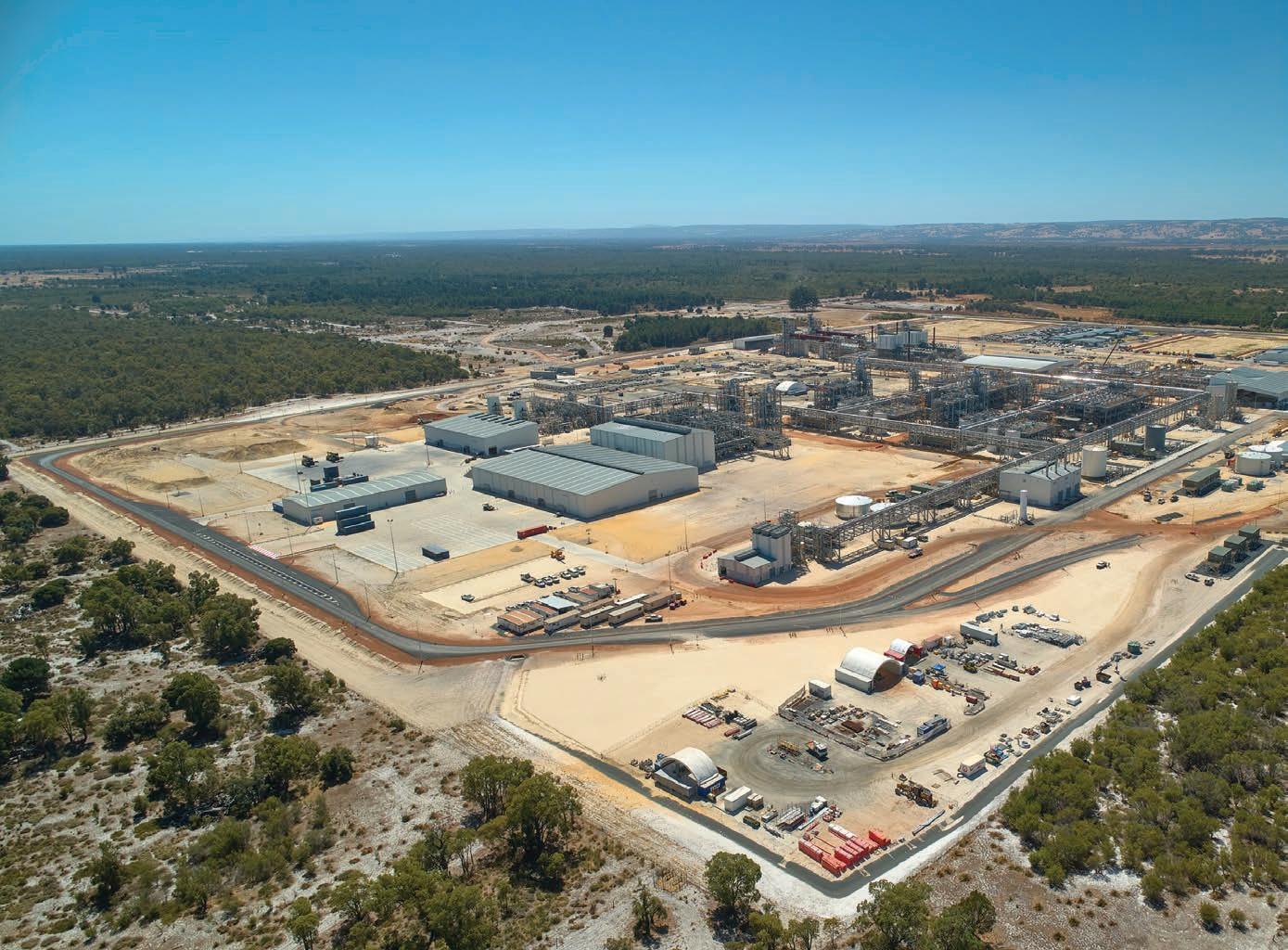
In the foreword of the Australia’s Identified Mineral Resources report, Federal Minister for Resources Madeleine King said Australia was blessed with a rich endowment of all the resources needed to make batteries, solar panels and wind turbines.
“Our lithium sector is going from strength to strength as global demand surges with the uptake of EVs,” she said.
“We currently produce more than 50 per cent of the world’s lithium from Western Australian mines.”
The problem – as some would call it – is we currently export lithium in massive amounts. Exports generated $5.3 billion in earnings in 2022, and soaring prices mean that figure is set to more than triple to $18.6 billion this year.
With cash coming in like that, why do anything differently? Well the Federal Government is now calling onshore lithium processing a matter of “national sovereignty”.
“Lithium has an extraordinary capacity, we need to not just dig it up,” Prime Minister Anthony Albanese said at the National Press Club in February.
“I want to make sure we use the lithium and nickel and other products that we have to make batteries here. That’s part of the vision of protecting our national economy going forward.
“I think we should be making solar panels here. I think we should be making so many more things here in order to protect our national sovereignty.”
A series of international messes in recent years has taught people the value of a resilient supply chain.
According to the International Energy Agency (IEA), China currently processes 60 per cent of the world’s lithium chemicals, and 80 per cent of the world’s lithium hydroxide.
Fortunately for us, China sources the spodumene it needs to support its gargantuan EV industry almost exclusively from Australia. Less fortunately for us, however, is the Chinese Government recently ended cash subsidies for households purchasing EVs.
This means that hyper-production at the end of 2022 has resulted in unsustainably high inventories of batteries and EVs, resulting in vendors being forced to sell at high discounts.
All of this drives down the price of lithium and adds more weight to Prime Minister Albanese’s warning about protecting the national economy. Minister King already touched on this in her foreword where she discussed Australia having all the materials it needs to produce its own sustainable energy products.
National sovereignty aside, lithium hydroxide delivered to China was fetching an average of $US65,000 per tonne in February 2023, meaning there’s economical upside to refining our own lithium.
Although the majority of Australian spodumene goes offshore, there are a handful of lithium hydroxide refineries in the country.
Kwinana in WA was commissioned in 2022 and is jointly owned by IGO and Tianqi. It was the first lithium hydroxide monohydrate plant in the country. The operation’s two production trains have a capacity of 48,000 tonnes per annum, with a third train due by 2024.
Another such project is the Kemerton plant owned by Mineral Resources (MinRes) and Albemarle, which is also in WA.
Albemarle recently commissioned two additional, wholly-owned, processing trains at Kemerton, which will double the plant’s lithium hydroxide production to 100,000-tonnes per annum. The expansion will make Albemarle the largest lithium producer in the country.
On top of that, Albemarle told the market in an earnings call that it is evaluating a broad range of additional lithium acquisitions, to go alongside its attempted $5.2 billion takeover of Liontown Resources.
Liontown has suggested that it’s considering an integrated lithium hydroxide refinery of its own once it gets its Kathleen Valley project up and running.
Wesfarmers also has its own lithium refinery in Kwinana, which it plans to build by 2025 with partner Sociedad Quimica y Minera de Chile (SQM), the second largest lithium producer in the world behind Albemarle.

So why do these major international players suddenly have a interest in moving their lithium operations further downstream on Australian soil?
It may be to pick up the slack left by the Chinese market, or to better support an expansion into the US and European EV
market. The non-insiders can only speculate for now, but it’s certainly interesting.
But lithium – something of a poster child of renewables – is far from the only option when it comes to sustainable resources. Some miners, like BHP, say lithium isn’t for them.
“There’s a number of dimensions for lithium that don’t quite match up with those requirements from a BHP perspective,” BHP chief executive officer Mike Henry said at a shareholder Q&A in March.
The Big Australian is instead choosing to prioritise copper, another mineral the world needs to meet electrification and power supply needs.
“Copper’s a bigger industry, both now and in the in the future,” Henry said. “The underlying assets can be quite largescale, which is wholly aligned with BHP’s capabilities.
“We believe that it’s going to afford better margin potential for the company over time.”
Henry said the company was also choosing to focus on nickel, another future-facing commodity.
“Electric vehicles actually use a lot more nickel than lithium, and we believe that nickel demand for batteries is going to be pretty durable,” he said.
BHP recently grew its exposure to copper and nickel through its acquisition of OZ Minerals, which owned copper assets in South Australia (Carrapateena and Prominent Hill) and a copper-nickel asset in Western Australia (West Musgrave).
You can be rest assured green-energy materials such as lithium, copper and nickel are going to drive Australia’s upstream and downstream narratives in the years to come. It will be interesting to see how the pendulum swings.
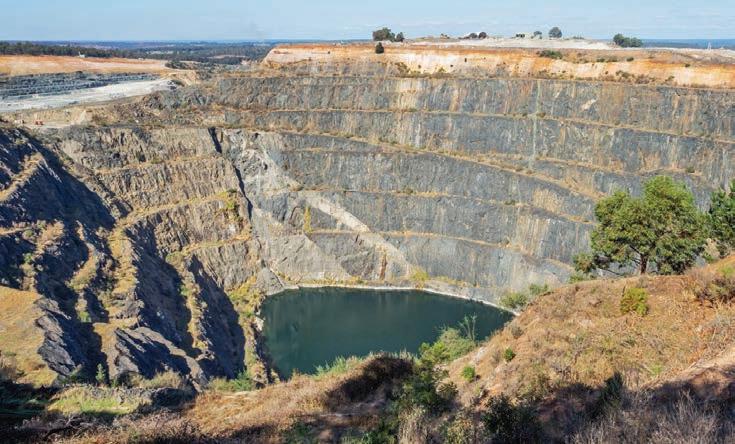
“In October 2021, our share price went up 200 per cent within a week, which was when Tesla announced they’d be moving all their standard range vehicles to LFP batteries.”
Brett Clark and his team at Avenira have been building a business model around an integrated supply chain that connects one of Australia’s largest phosphate deposits with an LFP (lithium iron phosphate) cathode plant in Darwin. Avenira has partnered with Taiwanese battery material pioneer Aleees to plan and design the plant, which is set to be one of only three licensed LFP cathode manufacturers outside of China.
The local and international interest in Avenira’s LFP plant is growing, partly driven by the electric vehicle (EV) sector’s diversification, where EV manufacturers are phasing out the use of NCM (nickel, cobalt and manganese) batteries for standard range vehicles and smaller personal transportation devices like e-scooters and e-bikes.
Clark, Avenira’s chair and chief executive officer, explained in more detail.
“After Tesla, many major vehicle manufacturers in the world, such as Volkswagen, Ford, Stellantis, Mercedes and BMW, announced that they’d be moving standard range vehicles to LFP batteries,” he told Australian Resources & Investment.
“One of the reasons for this was the predominance of EV battery fires in NCM battery EVs. NCM batteries, have thermal stability problems and need to be cooled, unlike LFP batteries.”
While NCM batteries have historically had a higher energy density than LFP batteries, the latter is catching up. Some LFP batteries now reach up to 85 per cent the energy density of their NCM counterparts.
There are other advantages, too.
“From an ESG (environmental, social and governance) perspective, LFP batteries are more recyclable – you’re not recycling cobalt, nickel and other toxic materials,” Clark said.
“They’re also cheaper to manufacture and they have other recharging properties which means you can get about 30 to 40 per cent more recharge cycles from them compared to traditional NCM batteries.”
Clark said Avenira expects the ex-China NCM and LFP cathode market share to be 50:50 by 2030 – insights derived from Benchmark Mineral Intelligence. And there is potential for further growth beyond 2030 as the green transition continues.
Phosphate mining at Avenira’s Wonarah project in the Northern Territory is nearing a trial phase, paving the way for a final investment decision (FID) to be made in the September quarter of 2023. The commencement of DSO (direct shipping ore) mining is planned for the second half of 2023. The DSO operation aims to ramp up to 40,000–50,000 tonnes of saleable ore product (SOP) per month, with the DSO phosphate product to be sold to a South-East Asian thermal phosphoric acid producer for further processing.

In two years’ time, Northern Territory-focused Avenira could be one of only three LFP cathode manufacturers outside of China, providing a key battery-grade material for global electric vehicle manufacturers.Avenira’s Wonarah phosphate project in Northern Territory.
While DSO production is taking place at Wonarah, and Avenira is generating first cashflow, the company will work alongside Aleees to advance the LFP plant in Darwin.
Having released a scoping study for the plant – which demonstrated its technical and commercial viability – Avenira is scheduled to commence the bankable feasibility study (BFS) in the September quarter of 2023. Avenira has appointed leading global engineering firm Bechtel to complete the BFS.
Subject to approvals, Avenira hopes to commence construction on the LFP plant in the second half of 2024, which could allow first LFP cathode production in 2025.
Once production has commenced, Avenira will aim to ramp up the plant to 10,000 tonnes per annum of battery-grade LFP production as soon as possible.
“Depending on how we negotiate offtake agreements and the uptake of those offtake agreements, which could be with a variety of partners, such as EV manufacturers and battery cell manufacturers, we may also decide to commence the second and third LFP trains,” Clark said.
“Each train will add another 10,000 tonnes per annum, respectively, and would commence a few months after the commissioning of each train to keep the construction and commissioning teams running from one train to the next. There’s a lot of efficiencies to be realised around how we schedule that.”
The LFP plant will be further de-risked by the fact it replicates Aleees’ operating LFP battery cathode material plant in Taiwan, on which Avenira and Bechtel completed due diligence in August 2022.
“Prior to 2015, Aleees were the largest LFP cathode material manufacturer globally,” Clark said. “But China has moved ahead massively around LFP cathode production since then through a lot of subsidies and low-entry costs from a capex (capital expenditure) point of view.
“We believe the plant has low technical risk in terms of implementation, commissioning and project development, and will be well suited to Darwin.”
Having achieved DSO production from Wonarah and first LFP cathode production from its Darwin plant, Avenira will then aim to produce a thermal phosphoric acid product from an additional processing facility at Wonarah.
This midstream product will then be used as feedstock for the Darwin LFP plant. Prior to the thermal phosphoric acid plant coming online, Avenira would source thermal phosphoric acid from
Aleees’ existing supply chains to feed the Darwin facility.
“The key thing for us as a company is to make a value-added product,” Clark said. “This starts off with direct shipping ore, before moving to an LFP cathode manufacturing facility in Darwin. Then we build out our phosphoric acid process as well.
“So we’re focused on integrating downstream manufacturing and dealing in materials that are going to be in continuous and growing demand in ex-China supply chains.”
Avenira’s aspirations are further supported by a Northern Territory Government that has indicated it is open for business.
“The Northern Territory Government has been proactive in tailoring solutions for companies who want to set up in the Northern Territory,” Clark said.
“Darwin is close to the markets we will ultimately deal with and has great existing infrastructure with rail, gas and port facilities in place.
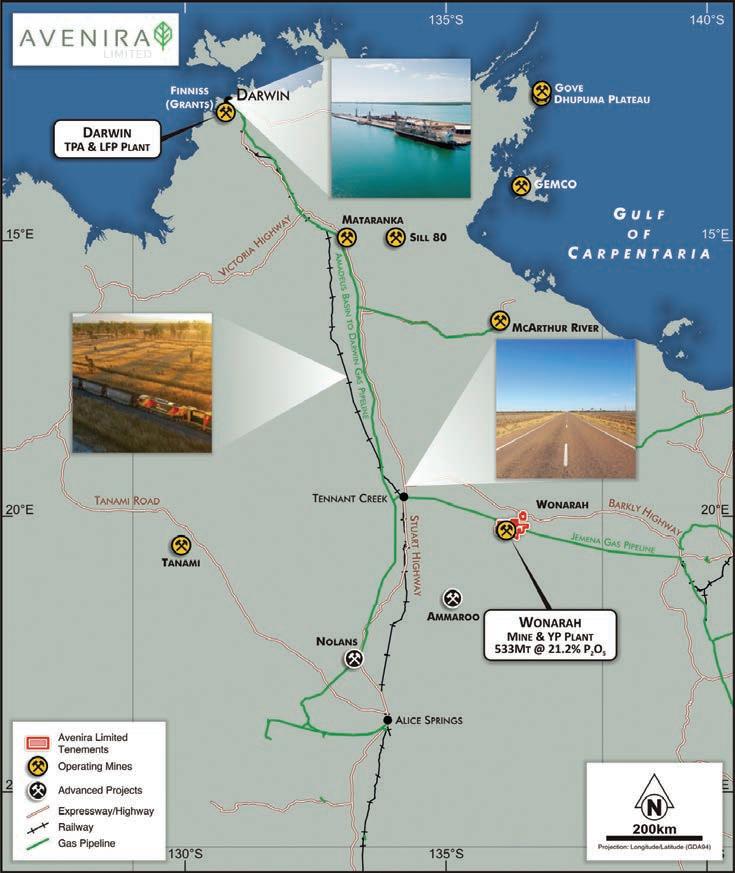
“Northern Territory energy is also among the cheapest in Australia, and it doesn’t rely on other states providing it, so that adds security.”
Avenira plans to power its Wonarah and Darwin operations on a combination of solar, wind and gas. Above all, onshoring mining and downstream processing practices means Avenira incurs fewer transport and logistical costs, making its integrated LFP supply chain more economical.
“The view that we’re getting from the global markets is that cathode material should be manufactured close to upstream materials, whereas battery cell manufacturers should be close to the electric vehicles and energy storage system manufacturers,” Clark said.
Avenira is building its vertically-integrated LFP operation at a time when geopolitical diversification is key to the success of the global battery supply chain and green transition more broadly.
It’s an operation that showcases the Northern Territory’s business focus and Australia’s rising downstream interests.
ARI sat down with Future Battery Minerals’ executive chair Mike Edwards to chat about the company’s exciting lithium discovery at Kangaroo Hills.
With a foot in Western Australia and Nevada – two of the world’s most exciting lithium jurisdictions – Future Battery Minerals (FBM) is poised to play an important role in the world’s green transition.
The company made an exciting lithium discovery in November 2022 at its Nepean nickel project in WA called Kangaroo Hills, which was the culmination of a diligent exploration journey for Future Battery Minerals’ technical director Robin Cox.
“In November last year, our technical director Robin Cox was drilling a couple of IP (induced polarisation) targets to the north of our Nepean nickel project,” Future Battery Minerals executive chair Mike Edwards told Australian Resources & Investment.
“That area has pegmatites everywhere and every time we drilled a pegmatite, Robin would assay for lithium, but we had never
really hit anything of significance. Then we hit a relatively narrow, high-grade spodumenebearing pegmatite.
“This showed to us that we’re in an area where fractionation has occurred, and the pegmatites have changed from barren pegmatites to high-grade spodumene.”
Future Battery Minerals rode the momentum of the lithium discovery to raise $2.65 million in early December, which allowed the company to hit the ground running in January.
“We drilled at both Nevada (FBM’s US lithium project) and Kangaroo Hills,” Edwards said. “Robin and his team had been mapping the whole Kangaroo Hills area and we found some significant outcrops of high-grade spodumene-bearing pegmatite which helped us target the first phase of drilling there.
“We completed that drilling in midFebruary, the results came out mid-March, and
we hit 29 metres at 1.36 per cent lithium. This was only from 38 metres deep, so very shallow, wide and high-grade mineralisation.”
Following these results, Future Battery Minerals quickly carried out another drill program at Kangaroo Hills, with results released in early May. These holes were step outs north, east and south from drill hole KHRC011 which delivered the 29m intersection.
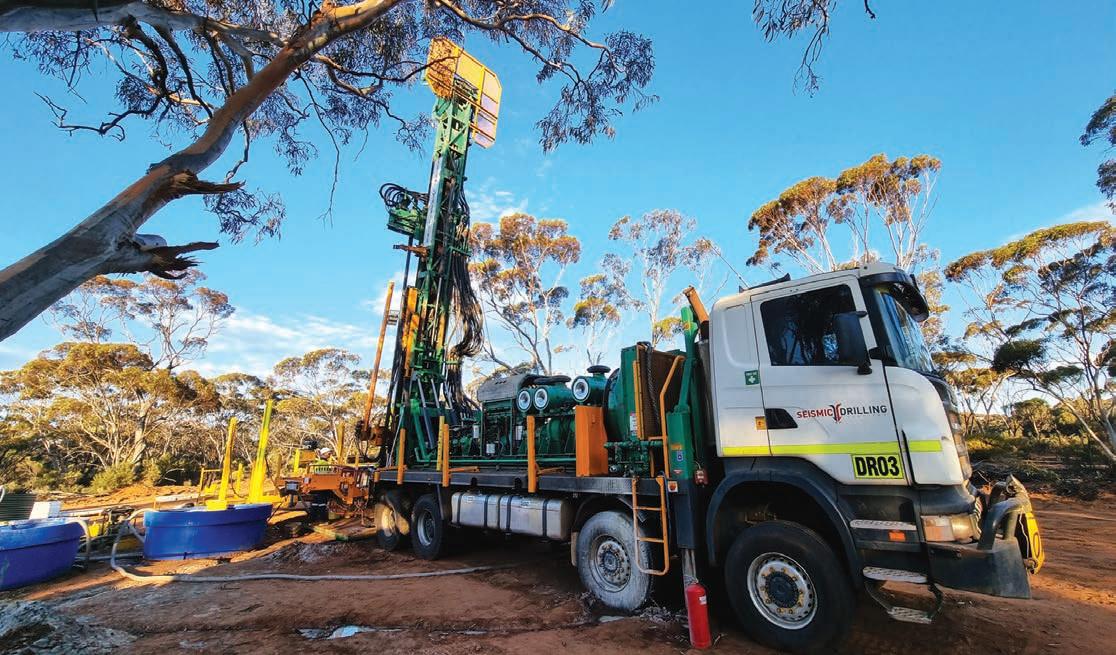
As announced in early May, drill hole KHRC017 would intersect 27m at 1.32 per cent lithium oxide from 64m, including 4m at 2.5 per cent lithium oxide, while several other drill holes would intersect thick high-grade lithium mineralisation as shallow as 8m below surface.
Edwards said drilling had demonstrated a pegmatite that is shallowly dipping to the north with a width of 200m and a strike length of more than 300m. This has been followed up
by more diamond drilling to further confirm the pegmatite’s orientation and provide bulk sample for early-stage metallurgical testwork.
Kangaroo Hills sits within a Tier 1 lithium province in the WA Goldfields. This region also hosts the likes of Mineral Resources’ Mt Marion lithium operation, Covalent Lithium’s Mt Holland lithium mine and Global Lithium Resources’ emerging Manna lithium project.
“We’re in a pretty hot part of the world and it’s very accessible,” Edwards said. “There’s main roads all around us, big players all around us. It’s a very strategic part of the world.”
Future Battery Minerals took possession of its Nevada lithium project in June 2022, seeing this as a strategic opportunity to establish a presence in this miningfriendly jurisdiction.
“Nevada was really starting to gain a lot of interest and there’s a lot of big companies that started investing there,” Edwards said. “We managed to pick up four very strategic packages of land relatively cheaply.”
The Nevada lithium project is different from Kangaroo Hills in that lithium is hosted within clays instead of hard rock, which Edwards said lends to more cost-effective exploration.
Future Battery Minerals completed its maiden reverse circulation (RC) drill program at Nevada in March 2023, with thick highgrade lithium claystone intersected at the Western Flats and San Antone East prospects.
“The interesting thing about Nevada and the reason it’s become such a hot part of the world, is it’s one of the only places in the US where there’s lithium,” Edwards said.
“Nevada is the most mining-friendly state in the US and hence, all these big companies are now really starting to focus on Nevada. You can’t pick up any more ground there at the moment.”
Edwards said FBM is surrounded by major companies looking to capitalise on Nevada’s rich lithium reserves. This includes American Lithium Corporation and its TLC project, which boasts a measured and indicated resource of 8.83 million tonnes (Mt) lithium carbonate equivalent (LCE).
American Battery Technology Corporation’s Tonopah Flats project is also nearby, which has an inferred resource of 15.8Mt LCE, as well as the only lithium-producing mine in the US –Albemarle Corporation’s Silver Peak mine.
“Lithium clays are relatively new, but once you get onto them, they’re easy to define,” Edwards said. “They’re like coal seams –they’re wide but they’re low grade, so the key with these deposits is the processing, and it’s the extraction of the lithium from the clays.
“That’s where all the time, energy and money is going at the moment – these big billion-dollar American companies doing research into the extraction of lithium from those clays.”
Future Battery Minerals’ maiden drill program at Nevada intersected lithium mineralisation of up to 109.7m at 766 parts per million (ppm) from 135.6m depth, including 29m at 1010ppm lithium. These results were announced in mid-April.
Edwards said these were significant results compared to the company’s neighbours –made even more impressive by it being a first
pass drill program. FBM aimed to commence follow-up drilling at Nevada in early June.
Alongside its Kangaroo Hills and Nevada projects, Future Battery Minerals also has a suite of nickel sulphide assets, including its Saints and Leinster projects, both of which are located on the Norseman-Wiluna Greenstone Belt in WA.
FBM released a Saints scoping study in April, which demonstrated the project’s potential to support a simple toll treatment operation within close proximity of several third-party concentrators operating in the Leinster-Kalgoorlie-Kambalda region.
Metallurgical testwork from saleable concentrate returned grades of 10–14 per cent nickel with excellent recoveries of 80–87 per cent nickel, 95 per cent copper and 84–92 per cent cobalt.
The operation would be centred on the St Patricks and St Andrews deposits, with an estimated $10–12 million of capital needed to develop the mine.
In early May, FBM announced it was selling its Nepean nickel project to Rocktivity Nepean for $10 million. This will further support the company’s exploration efforts at Kangaroo Hills and Nevada.
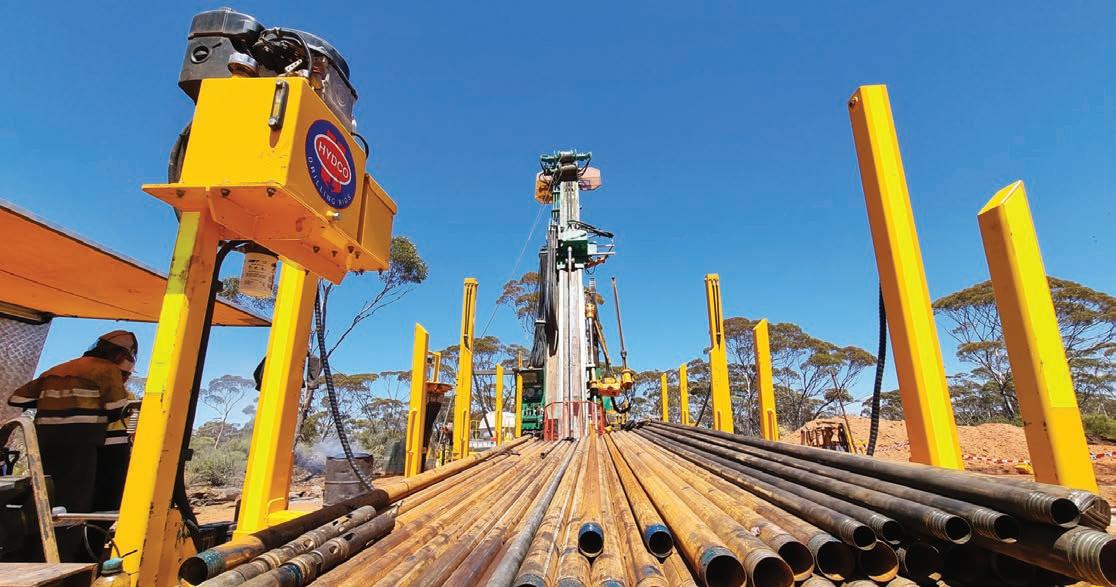
Future Battery Minerals not only has exposure to two of the most important materials for the world’s green transition – lithium and nickel – but holds assets in strategic, Tier 1 jurisdictions.
And with plenty of high-grade ground to follow up at Kangaroo Hills and Nevada, there will be plenty of news to come out of the FBM camp in the next 12 months and beyond.
With its recent acquisition of the Express lithium project in the geologically bountiful region of James Bay, Canada, Recharge Metals is set for an exciting future.
Geoscience Australia’s recent report, ‘Australia’s Identified Mineral Resources’, ranked the country as number one in the world for lithium production, and number two for known lithium resources.
Overall, Australia accounted for 53 per cent of the world’s lithium supply in 2021.
Global lithium consumption is largely driven by the demand for rechargeable batteries, particularly in electric vehicles (EVs), and EV sales are projected to balloon over the next decade and beyond.
But while many companies rush to Western Australia for lithium, others, like Recharge Metals, have their sights set internationally.
Recharge Metals recently acquired the Express lithium project in the highly prospective James Bay region of Quebec, Canada, covering two contiguous claims across a 74-square-kilometre project area.
“What makes James Bay so unique is that it’s a relatively tight cluster of worldclass lithium projects, and Express is located right in the middle of it,” Recharge managing director Felicity Repacholi-Muir told Australian Resources & Investment

“Quebec is looking like it’s going to be one of the leading areas for not just lithium production, but also subsequent exploration of additional lithium projects.”
Just 12km to the north-west of Express is Allkem’s James Bay deposit, a mine capable of producing 321,000 tonnes of spodumene concentrate per year. And 15km south-west is Cygnus Metals’ Pontax lithium project, which is returning high-grade assays of up to 5 per cent lithium oxide.
Cygnus recently acquired an additional 9km of strike on the Chambois Greenstone Belt which Express’ smaller claim block is located on, meaning Cygnus now closely neighbours the project. This demonstrates the growing competitiveness of the region, and Recharge Metals’ intelligence to establish ground.
Located to the north-east of Express is the Corvette project, owned Patriot Battery Metals – a company chaired by former Pilbara Minerals boss Ken Brinsden.
“The James Bay region itself is becoming particularly important in the lithium world,” Brinsden told the Resources Rising Stars Summer Series late last year.
“There has already been some discoveries, and there may well be more. But it’s a great place to be building a mine.”
Prior to Recharge’s acquisition, the Express project had never been explored for lithium.
“It’s a unique area to be in,” RepacholiMuir said. “We’re first on ground for lithium exploration, which offers a whole host of opportunities, but we’re also in a renowned and highly prospective area.
“It’s not very often you see these kinds of grassroots projects just down the road from major lithium production hubs.”
While no exploration has taken place at Express, outcropping pegmatites are evident from satellite imagery, with high-priority pegmatites identified by the local government. This has led to the
region being named the ‘spodumene suite’ by Quebec’s Ministry of Natural Resources and Forests.
Canada is considered a Tier 1 mining jurisdiction. Quebec, in particular, ranks eighth in the world for mining investment attractiveness, above South Australia, New South Wales, Queensland, Victoria and Tasmania, according to the Fraser Institute’s latest annual survey of mining companies.
“It’s a lot simpler to raise funds to get a project off the ground when you’re working in a mining jurisdiction like Canada,” Repacholi-Muir said. “Lithium – with the electric vehicle market – is a fantastic commodity to get into. When you can pick up a project in an emerging worldclass lithium province in a Tier 1 mining jurisdiction, it’s simply too good to pass up.
“It ticked a lot of boxes for us and our shareholders.”
The lithium price has pulled back this year following the record highs of 2022 due to a drop in demand from China, but the battery metal is still trading at 18month highs.
According to the International Energy Agency (IEA), China currently processes 60 per cent of the world’s lithium chemicals, and 80 per cent of the world’s lithium hydroxide.
China sources much of the spodumene concentrate it needs to support its enormous EV industry from Australia, but the Chinese Government recently ended cash subsidies for households purchasing EVs. This has resulted in unsustainably high inventories of batteries and EVs, vendors being forced to sell at discounts, and lower demand for spodumene.
But China is not lithium’s growing market.
As Australian miners look to onshore lithium processing, they are turning to Europe and North America as more reliable long-term partners.
This means the Express project, being situated in Canada, is in an even more supreme location given North America’s growing EV industry.
And just because Express is new doesn’t mean its untouched.
The James Bay region has been historically explored for gold, which means an array of geological data –some of which refers to pegmatites in the land – is already available to aid lithium exploration.
“We’re also well supported by the excellent infrastructure in the area,” Repacholi-Muir said.
“We are less than 12km from the main highway and 15km from a well-resourced logistics hub with accommodation.
“What also puts the area in a unique position is its ability to produce lithium with green energy due to Quebec’s extensive hydropower network, which is key when you’re
looking towards greener production for operations.”
In purchasing the Express project, Recharge Metals engaged a major stakeholder in the North American lithium space, DG Resource Management (DGRM), who first identified the Express project.
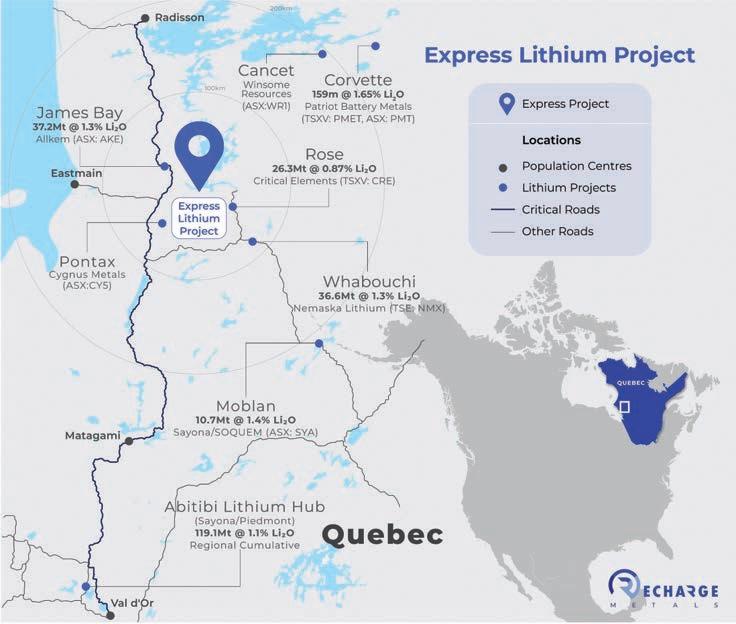
“The DGRM team is really well-versed in identifying prospective projects, so it’s exciting for us to have a relationship with them,” Repacholi-Muir said.
“They also identified Patriot’s Corvette project, which has been getting some amazing results of late.
“The fact that they’ve come on board with Express with quite a significant stake at 18.8 per cent really bodes well for the project.”
DGRM has a geological consulting arm, Dahrouge Geological, which will lend its services to Recharge for the development of Express.
“We’re working really closely with the Dahrouge team, who is well-versed in exploration for spodumene bearing pegmatites, and who know the geological terrain of Quebec,” Repacholi-Muir said.

“Our initial exploration activities will be boots-on-the-ground field mapping and surface sampling. That’ll be a helicopterborne program.
“We will be traversing the project and going to all of these key target areas with the aim of identifying spodumenebearing pegmatites, which we’re fully funded for.
“Once that’s done, a drilling campaign is set for later in the year.”
The RIU Sydney Resources Round-up showcased the exploration companies that will be key to a net-zero future.
Across three days in May, the 2023 RIU Sydney Resources Round-up offered a platform for 90 ASX-listed resource companies to showcase their achievements and project developments before brokers, investors and delegates.
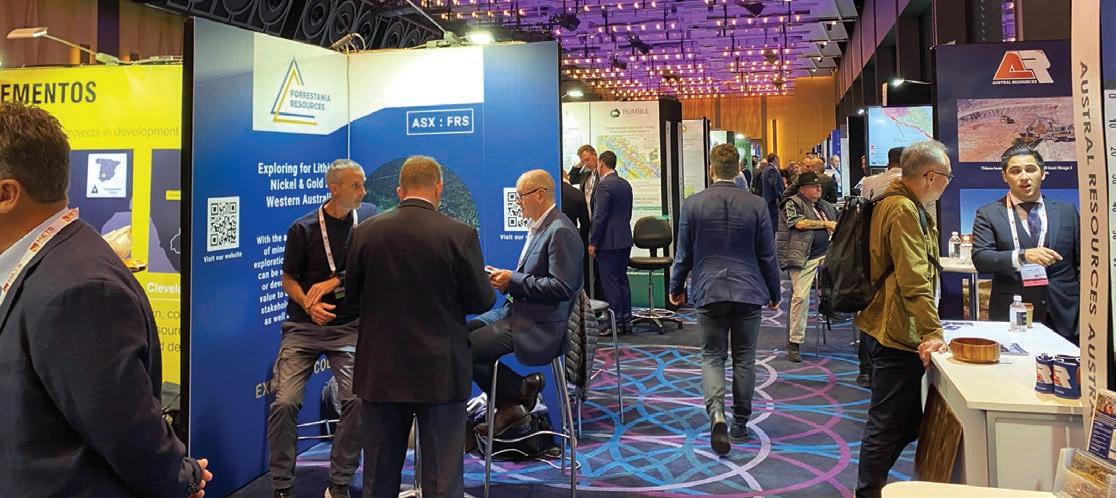
Gold and critical minerals were key focuses of this year’s conference, while keynote presentations offered analyst insights into the emerging trends affecting the mining and exploration industries.
In the final presentation of day one, commodities advisory firm CRU unpacked the future of critical minerals, first by juxtaposing the demand outlook for battery metals against the demand outlook for coal and iron ore.
CRU foresees lithium demand increasing 18.5 per cent between 2022 and 2027, with neodymium-praseodymium (NdPr) rising by 10.5 per cent, cobalt by 9.4 per cent and nickel by 7.7 per cent across this time period.
But the demand for thermal coal, metallurgical coal and iron ore are all expected to decline between 2022 and 2027, with thermal coal the biggest drop at more than 5 per cent.
CRU senior consultant David Royle explained why the world is favouring critical minerals.
“So why has demand (for critical minerals) taken off in recent times?” he said. “In short, it’s decarbonisation and geopolitics.”
Royle explained that more countries are implementing emissions trading schemes or carbon tax regimes in an effort to decarbonise.
“Australia has recently legislated a 43 per cent emissions reduction target to be achieved by 2030, which will be enforced by the recent safeguard mechanism,” he said. “This is clearly going to require a whole lot more green metals in order to become a reality.”
Royle said geopolitics has become “inextricably linked” with the critical minerals sector in the wake of global geopolitical crises.
“The war in Ukraine has exposed the vulnerability of supply chains and governments have become a bit more protectionist in order to try to boost domestic energy security,” he said.
“China is clearly the key midstream processor of metals and minerals. A disruption in trade with China would be catastrophic to Australia’s decarbonisation goals and the overall economy.
“There is also some legislation that has been passed to try to boost downstream domestic production of critical minerals.”
This includes the Inflation Reduction Act in the US, which Royle said “doesn’t do much for inflation” but does create tax incentives for original equipment manufacturers (OEMs) to build up battery manufacturing and incentivises upstream mine development for free-trade partners such as Australia.
While governments can play their part to support increased critical minerals production, Royle said the bucks stops with the mining industry, who have the deposits and expertise to unlock minerals from the ground.
Royle also discussed how the electric vehicle (EV) industry is accelerating the global critical minerals narrative and the key role Australia has to play in not only supplying the raw materials for green technologies but also developing a downstream industry.
“Not only lithium, but Australia has all the composite materials to get to pCAM (precursor cathode active material) or CAM (cathode active material) refining,” he said.
“High levels of value add can be achieved by developing downstream capabilities.”
• Tuckanarra has five open pits mined in the 1990’s that targeted shallow oxide ore
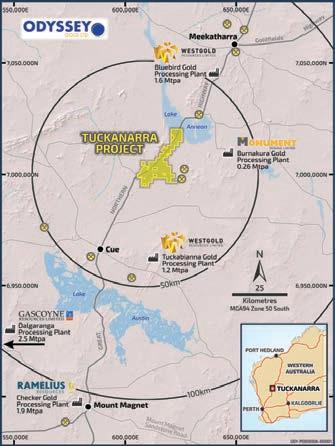
• Wide shallow oxide intersections and highergrade mineralisation extending to 200m below surface
• Attractive grade of 3.4g/t Au mined in the mid 1990’s compared with 0.89-2.8g/t Au currently being mined in the district
• Discoveries are on granted mining leases in a district with over 7.5Mtpa of milling capacity

• The last mining on the Tuckanarra Project was in the mid 1990’s when the gold price was A$550/oz
Recent drilling at Highway Zone returned up to 43m at 8.3g/t in a region with increasing M&A activity
New World Resources is poised to bring one of the world’s highest-grade copper projects into production, with recent scoping studies demonstrating its Antler deposit in Arizona, which grades 4.1 per cent copper equivalent (CuEq), is economical.
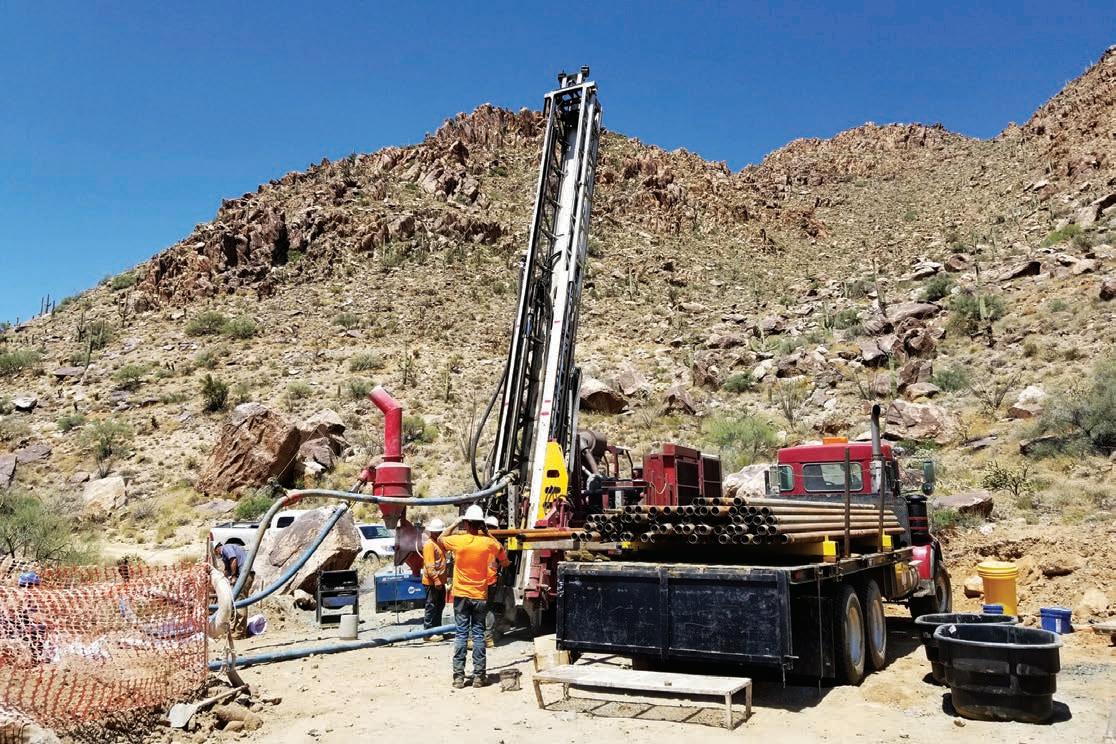
The company intends to bring the project into production in 2026–27, when it will ramp up production to a nameplate capacity of 1.3 million tonnes (Mt) per year.
A 2023 scoping study outlined Antler’s potential to support a 13-year mine life with 15.4Mt of ore mined to recover 381,400 tonnes of total CuEq, based on an average diluted head grade of 3 per cent CuEq.
This is a significant uplift from a 2022 scoping study which demonstrated the potential to mine a total of 9.3Mt at approximately 1Mtpa over 10 years at Antler.
New World’s recent study indicates the operation would generate 50 per cent more revenue, for a total of $US3 billion ($4.4 billion), while incurring lower costs.
“Because of the economies of scale we’re achieving due to the larger production profile and longer life, the margin has gone up,” New World managing director Mike Haynes told Australian Resources & Investment.
“Operating costs have gone down about 12–14 per cent, so the margin has gone up
over a longer operating period; so we now make $US1.5 billion free cash over the initial operating period.
“The key is a lot more revenue at lower operating cost, which gives us a lot more free cash flow.”
A bigger operation creates operational synergies, so a larger deposit reduces the cost per tonne.
“A lot of the cost in processing is the labour component,” Haynes said. “So whether we’re operating at 1 million tonnes per annum or 1.5 million tonnes per annum, we still need the same number of people working in the processing plant.
When New World Resources changed its focus to copper four-and-a-half years ago, the company targeted the acquisition of a high-grade deposit that it could take to production relatively quickly.Drilling at New World’s Antler copper project.
“Likewise, if we’re running an operation, people like accountants, safety personnel, HR personnel – our general and administration (G&A) – are all on-site.
“Again, if you’re operating at 1 million tonnes per annum, you need (say) 16 people. If you’re operating at 1.5 million tonnes per annum, you still need 16 people. So you start benefiting from these economies of scale.”
New World wants to maximise Antler’s size, but the company also recognises the value of fast-tracking the deposit to production so it can use cash flow from operations to continue to explore and expand.
And given Antler is a volcanogenic massive sulphide (VMS) deposit, there is plenty of potential to find both extensions of Antler itself as well as other similar deposits in close proximity – as VMS deposits typically occur in clusters.
“We see that with what we’ve already got, Antler can be a very profitable operation for relatively modest capital expenditure (capex),” Haynes said.
In line with its medium-term growth aspirations, the company has strategically acquired additional ground to set itself up for future success.
And in recent early-stage exploration work along strike from Antler, New World has delineated a series of strong copper-in-soil geochemical anomalies, with very similar characteristics to a comparable anomaly over the Antler deposit.
These anomalies, which include a 1.5km-long soil anomaly at the Copper Knob prospect, could add to the resource base and mine life in the future.
“In the entire project area to date, we’ve only drilled 600 metres of strike – and that’s been entirely at the Antler deposit itself,” Haynes said. “Because of our phenomenal exploration success rate, as we’ve drilled deeper and deeper in that corridor, we’ve continued to find more and more thick and high-grade mineralisation.
“But we see that there’s a lot of potential to find more mineralisation both to the south and north of Antler.
“We have outlined numerous strong copper-in-soil geochemistry anomalies that coincide with multiple small pits and historic workings, and we now also have strong induced polarisation geophysical anomalies that also coincide with these target areas. But none of these anomalies have ever been drill tested, so there’s potential for us to make additional discoveries here.
“All of these targets are within a few kilometres of the Antler deposit, so if we do make a discovery, we can readily truck ore from these areas down to the Antler processing plant and expand our production profile, which would make the operation even more profitable.”
New World also holds ground 75km to the southeast of Antler at its Javelina copper project, which could provide additional highgrade feed for its processing plant at Antler in the future.

“Anything that can be added incrementally – whether it’s half a million or two million tonnes – to our Antler throughput can add a lot of value in the future,” Haynes said.
“As we’ve become more and more confident that we’re going to build a standalone
processing plant at Antler, if there’s highgrade mineralisation within trucking distance of Antler, then we’ve been investigating how we can incorporate that into our mine plan.
“So we’ve acquired a 100 per cent interest in the Javelina copper project covering almost 4000 acres, which contains the same geological sequences that host a number of other known high-grade VMS deposits.”
Deposits adjacent to Javelina include the Old Dick mine, where 614,000 tonnes has been mined at 3.36 per cent copper and 10.6 per cent zinc in the past, and the Bruce mine where 746,000 tonnes has been mined at 3.65 per cent copper and 12.7 per cent zinc in the past.
Haynes elaborated on Javelina’s potential.
“Just like the philosophy at Antler, where when there’s one VMS deposit, there might be two, and when there’s two, there might be three, immediately around Javelina there is a series of six VMS deposits,” he said.
“All of these are hosted by the geological horizons that extend into our project area. So we’ve secured the rights to them with a view that discovering even an extra one or two million tonnes could have a material impact on the economics of the Antler project.”
With a strong long-term demand outlook for copper amidst the green energy transition, many analysts are predicting a future supply deficit. This is in part because of a limited pipeline of advanced copper projects – a problem compounded by the fact that copper mines have extensive development timelines.
This is why New World Resources is an enticing investment proposition.
“To discover an economically viable copper deposit is very challenging,” Haynes said. “It takes a long time to find them, then typically it takes a long time to permit them, a long time to fund them and a long time to construct them before bringing them into production.
“It’s a widely held view that there’s going to be a copper supply shortfall in the coming years, and because of the complexity of bringing copper plays into production, I don’t see that supply gap being filled anytime soon.
“So I see New World being in a really strong position to bring our project into production relatively quickly, at a time when there’s going to be sustained high demand for copper, because so few other companies are bringing projects online.
“And that’s precisely why, four years ago, we set about finding a high-grade deposit that we could take into production relatively quickly.”
Odyssey Gold is advancing a strong pipeline of gold projects that could inject a much-needed high-grade infusion into the Murchison region of Western Australia.
The company could hold the key for its neighbours, such as Westgold Resources, Ramelius Resources and Gascoyne Resources, who are looking for high-grade tonnes to feed their processing plants.
“The operations of mid-tier mining companies in the area are mineconstrained,” Odyssey Gold chief executive officer and managing director Matt Briggs told Australian Resources & Investment.
“This means they’re not making the cash they hope to be making due to the low grades they’re mining underground to try and fill their mills. They’re doing a lot of good work to keep their costs down at their ageing mines, but mining two grams per tonne underground is hard work.
“The five shallow open pits at Tuckanarra in the mid 1990s mined two-and-ahalf to three-and-a-half grams per tonne. We are expecting to see the same from our future open pits, with some of the mineralisation starting at surface.”

Odyssey Gold’s Highway Zone, one of five advanced prospects within its Tuckanarra gold project, could be the answer the Murchison region’s midtier producers are looking for, having demonstrated consistent thick oxide mineralisation across over 300m of strike.
“At the Highway Zone we consistently see intersections of 10–20 metres true width with over three grams per tonne or more in oxide extending to depth,” Briggs said.

Significant intersections from the Highway Zone in recent months include 43m at 8.3 grams per tonne (g/t) from 41m at drill hole CBRC0136, including 12m at 27.5g/t gold. This included an 80.9g/t hit across 3m.
Drill hole CBRC0139 intersected 33m at 3.4g/t gold from 73m, while drill hole CBRC0143 hit 21m at 3.3g/t gold from 65m.
These results built on the Highway Zone’s initial discovery hole, where Odyssey Gold intersected 84m at 2.5g/t gold from 25m in August 2022.
“Once we intersected an interval 84 metres wide, we knew we were onto the extension of the mineralised trend. The 300metre shoot along strike of the historic pits is much thicker and more consistent in grade than what you’re seeing in the other deposits on the project,” Briggs said.
“Our focus for the last six months has been drilling shallow oxide at the Highway Zone to resource spacing, understanding the controls of gold mineralisation and drilling the extensions along strike.”
Briggs explained the geological nature of the Highway Zone in more detail.
“Along the Highway Zone’s 300 metres of strike, we are regularly intersecting 25 gram-metres or better,” he said.
“And there’s a 150-metre-long extra-highgrade shoot where we’re getting consistent intersections of over five grams (per tonne). It’s a 20-to-30-metre true width shear zone containing three to seven parallel veins. Often the veins are continuous across an interval of 40 metres wide.”
“We have confidence this will be an open pit in the future. The 150-metrelong high-grade shoot is only drilled to 180 metres below surface, and we expect further drilling to extend the underground mining potential down plunge. Murchison deposits often continue down 700 to 1000 metres below surface, and we have real potential for that scale here.”
Briggs said Odyssey Gold could proceed to grow the Highway Zone and the Tuckanarra project by itself and toll treat at a neighbour’s mill, it could enter into a joint venture or sell the project for the right price.

“Much of the project is covered by a granted mining lease. Metallurgical testwork, cultural heritage, and environmental surveys have previously been completed, significantly de-risking the project and expediting development.”
And while Odyssey Gold is generating plenty of interest from its gold-mining peers, the company still has a few objectives to achieve before it actions any opportunities.
“We’re still determining the scale of the project,” Briggs said.
“It’s only nine months ago that we started to unlock the potential of the Highway Zone and have already seen a dramatic change to the outlook of the project.
“There are a number of similar opportunities that need to be assessed before settling on the path forward. The deepest hole in the Highway Zone is only 180 metres below surface, so we’re really only getting started there and we are exploring for additional shoots along strike.”
In late-April, Odyssey Gold announced reconnaissance AC (aircore) drilling that had extended the Highway Zone’s ultramafic stratigraphy for an additional 650m.
“The project continues to grow,” Briggs said. “We just recently announced aircore intersections of two metres at five-and-a-half grams (per tonne). These are 260 metres to the east of the most recent resource RC (reverse circulation) drilling.
“High grades have been intersected in oxide demonstrating the potential for additional shallow oxide mineralisation to be defined.
“This area … has surface workings for 200m of strike and grab samples assayed last
year yielded up to 18.5g/t gold and March results of 3m at 1.5g/t in scout RC drilling, highlighting the potential for the continued growth of this system.”
All data and assays from the recent successful drilling programs at Tuckanarra will underpin a maiden JORC 2012 open-pit resource estimate, which the company hopes to release in the not-too-distant future.
“One of the first objectives Ian Middlemas, the Odyssey Gold chairman, put to me was to quantify the openpit resources while understanding the shoot controls to allow the company to understand Tuckanarra’s underground potential,” Briggs said.
Given the strategic importance of Odyssey Gold’s high grades to the Murchison gold district, you can guarantee the company’s peers, shareholders and interested investors will be eagerly awaiting the maiden Tuckanarra resource.
Odyssey Gold’s strategy to unlock the high-grade potential of Tuckanarra could prove to be the catalyst that sparks the Murchison’s next gold mining chapter.
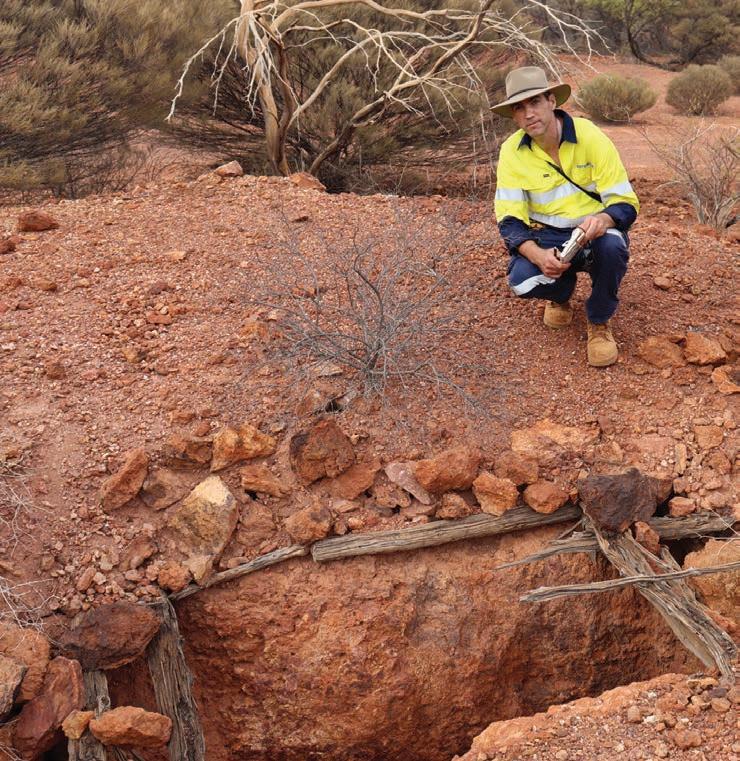
According to Jeames McKibben, principal consultant (project evaluation) at SRK Consulting, valuing mining assets is increasingly complex due to various issues such as commodity-price volatility, COVID-19 and emerging environmental, social and governance (ESG) trends.
McKibben has worked on mining-asset valuations and independent technical reports – to support project finance – for almost two decades.

“I expect to see further increases in asset values across the mining sector for a sustained period,” McKibben told Australian Resources & Investment. “But within that, there will be volatility in asset prices.
“Mining companies must be well prepared when having their assets independently assessed and valued.”
Commodity-price assumptions are a key driver of asset-price volatility. After rising in 2021 and 2022, commodity prices in aggregate have retreated this year, amid expectations of slowing global growth and recessionary fears.
Prices for lithium, cobalt and other critical minerals have fallen this year after soaring gains in the past two years. Metallurgical and thermal coal prices surpassed their previous highs in 2022, but are lower this year.
In contrast, the gold price has rallied in 2023. Proposed mergers in the gold sector have featured.
“Volatility has seen transaction counterparties adopting different positions with respect to commodity prices,” McKibben said. “It is evident that some companies are basing their expectations of commodity prices approximating prevailing spot prices, while others adopt a view based on long-term commodity-price forecasts.”
Uncertainties associated with COVID-19 compound the present valuation challenge.
“The pandemic was a turbulent time for valuing assets and its impact is ongoing,” McKibben said. “The period saw transaction volume and values fall, resulting in fewer meaningful transactions to guide current asset values.
“For example, how does today’s asset value compare to prices paid for similar
assets during COVID-19 given challenged supply chains, labour constraints and productivity declines over that period?”
ESG considerations are an important aspect for valuation practitioners.
“While certain issues determine the practical constraints and value of mining assets, the priority and breadth of these aspects to the valuation exercise has progressively increased,” McKibben said.
“There has also been extensive repositioning with respect to the ESG credentials of each metal. Clean-energy metals have been in favour, as have traditional stores of value, such as gold.
“In contrast, fossil fuels have lost favour due to ESG factors, yet coal has been among the best-performing commodities over 12 months, in part due to geopolitical factors.”
Mining companies are increasingly factoring ESG trends into asset-value assumptions.
“Certain parts of the market have been slow to recognise this trend,” McKibben said. “But that is changing as companies gradually reposition in light of longer-term
It is critical companies have realistic expectations and a proactive working relationship with asset valuers.
trends in clean energy and there is a greater focus on ESG aspects of due diligence and the associated implications for asset values.”
The recent emergence of artificial intelligence (AI) is another growing consideration in asset valuations.
While machine learning has enabled recent advances in exploration and mine production, it is yet to make an impact in mining asset valuation. This is likely to change in the near term due to the requirement for real-time, cost-effective and reliable data, as well as the need to support research, data compilation and analysis of increasingly complex models, and test a larger range of valuation assumptions.
“It’s early days, but the use of AI offers the potential to reduce costs, increasing the turnaround of valuations, and provide more detailed information regarding an asset’s value,” McKibben said.
“AI is likely to play a larger role in researching and preparation of mining asset valuations near term.”
Companies can assist valuers in the generation of mining-asset valuations in three main ways.

The first is context.
“Understanding the context of the valuation exercise and the intended audience has never been more important,” McKibben said.
“Is the valuation for internal purposes or will it be released to the market and thus subject to a high regulatory overlay through the JORC or VALMIN codes? Who are the intended users of the valuation: domestic or international investors, banks, other mining companies?
“Each will adopt a slightly different lens.”
Distinguishing between market and investment value is another consideration.
“Is the company seeking market value, as defined by VALMIN, for an asset based on prevailing market conditions?” McKibben said. “Or does the company require an estimate of investment value that considers what the asset is worth in the
hands of a particular strategic buyer locally or overseas?”
Furthermore, companies should set realistic expectations with respect to value.
“Understandably, companies want to present their assets in the best light and there is a tendency to seek value aligned to inflated expectations, particularly when raising capital or undertaking a transaction,” McKibben said.
“But the VALMIN code, as part of the broader Australian regulatory environment, places certain constraints on the valuation process and is very specific on how such values are presented to the market.
“In disclosing the perceived value of mineral assets, a balanced approach and recognition that stakeholders may take an alternate view regarding underpinning assumptions and value outcomes are key.”
Working closely with asset valuers is the third response to heightened volatility. Some mining companies may enable the valuer to more properly recognise an asset’s value by providing more comprehensive
data for valuers, having people on hand to answer questions, and understanding the steps involved in the valuation process (see breakout box below).
“Practitioners typically have to produce an asset valuation within three weeks to meet regulatory requirements,” McKibben said.
“Having well-compiled asset information before the valuation process begins makes such a difference when deadlines are tight. Significant time can be lost if the valuer has to chase up data or work with incomplete information, and often results in wider or more conservative valuation ranges.”
This is why collaboration is another important part of the valuation process.
“The valuation of a mining asset is an iterative process,” he said. “Companies that do this well typically aid the valuer’s understanding of an asset’s life-of-mine planning, ore reserves and mineral resource, exploration potential and risks.
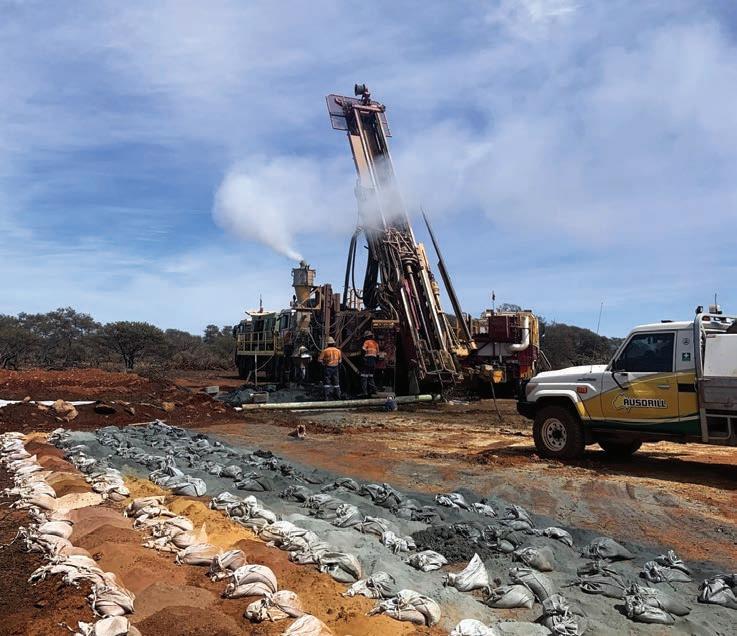
“These companies may also provide information for the valuer on potential comparable assets and recent transactions in their market. Also, they help the valuer recognise how a project is being de-risked.”
Understanding how a valuation is achieved should be part of a collaborative process.
“For some companies, the temptation is to jump straight to the headline number and agree or disagree with it,” McKibben said.
“A better approach is breaking the valuation into a series of steps and understanding where parties disagree on the technical and economic assumptions supporting an asset’s value.
“The goal is to work together to minimise these perception gaps.”
Most of all, mining companies need a structured valuation process.
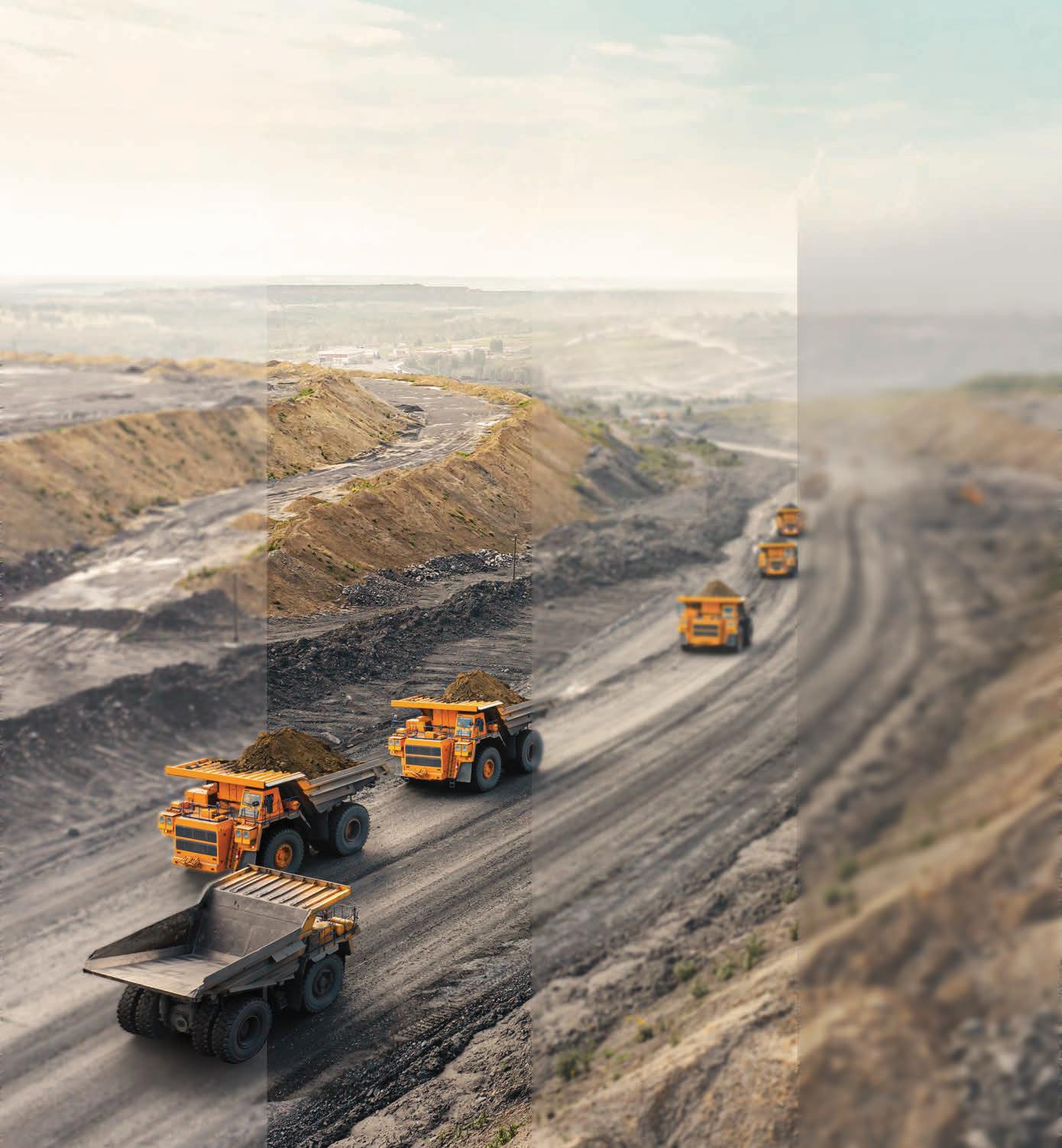
“This is not only about helping companies achieve a well-reasoned value for a mining asset,” McKibben said.
“It’s also having information to guide capital allocation and budgeting decisions, and is part of risk management and stakeholder communication.”
SRK Consulting is a leading, independent international consultancy that advises clients mainly in the earth and water resource industries. Its mining services range from exploration to mine closure. SRK’s experts are leaders in due diligence, technical studies, mine waste and water management, permitting, and mine rehabilitation. For further details, visit www.srk.com
1. Scope: Be clear on the valuation’s purpose and users of that information.
2. Seek advice: Ensure the valuer’s experience and skills align with the company’s commodity and needs. In particular, mid-tier miners and juniors without sufficient internal resources should engage with valuers who have extensive experience in the relevant market.
3. Identify timeframes: Typically, asset valuations must be produced quickly. Understand key activities, associated timeframes, and determine how to facilitate the process.
4. Due diligence: Before commencing, ensure the project database is sufficiently comprehensive, accurate and accessible for the valuer.
5. Comparable assets/transactions: Data regarding recent transactions involving similar assets can help the valuer to understand the company’s view and expectations, gauge its current market value, and support the valuation process.
6. Working group: Establish a working group and key point of contact to liaise with the valuer to ensure the timely provision of information.
7. Build understanding: Help the valuer understand the asset. For example, how much of a defined mineral resource may convert to ore reserves in the future? Do satellite deposits offer value for an acquiring party and add further exploration potential? How is the asset being de-risked? Is it supported by surrounding infrastructure?
8. Valuation process: Understand the valuation approach, as this will impact delivery timelines. Is it a topdown or bottom-up? What steps are required? What key technical and economic assumptions inform each step? How do these vary between different parties? Is there a desire for consensus? Can common ground be found on differing assumptions and asset-value perceptions?
9. Be realistic: Recognise the constraints under which the valuation is produced and the responsibilities of releasing such information to the market.


This year has ushered in a global copper shortage, with a major deficit of 1.9 million tonnes (Mt) forecast by 2030.
Due to the commodity’s expansive use in equipment and industrial machinery, copper has historically been a leading indicator for economic health. Material adjustments in the demand or supply of copper can therefore result in sustained economic distress, namely in the form of global inflationary pressures that are compelling central banks to maintain higher interest rates.
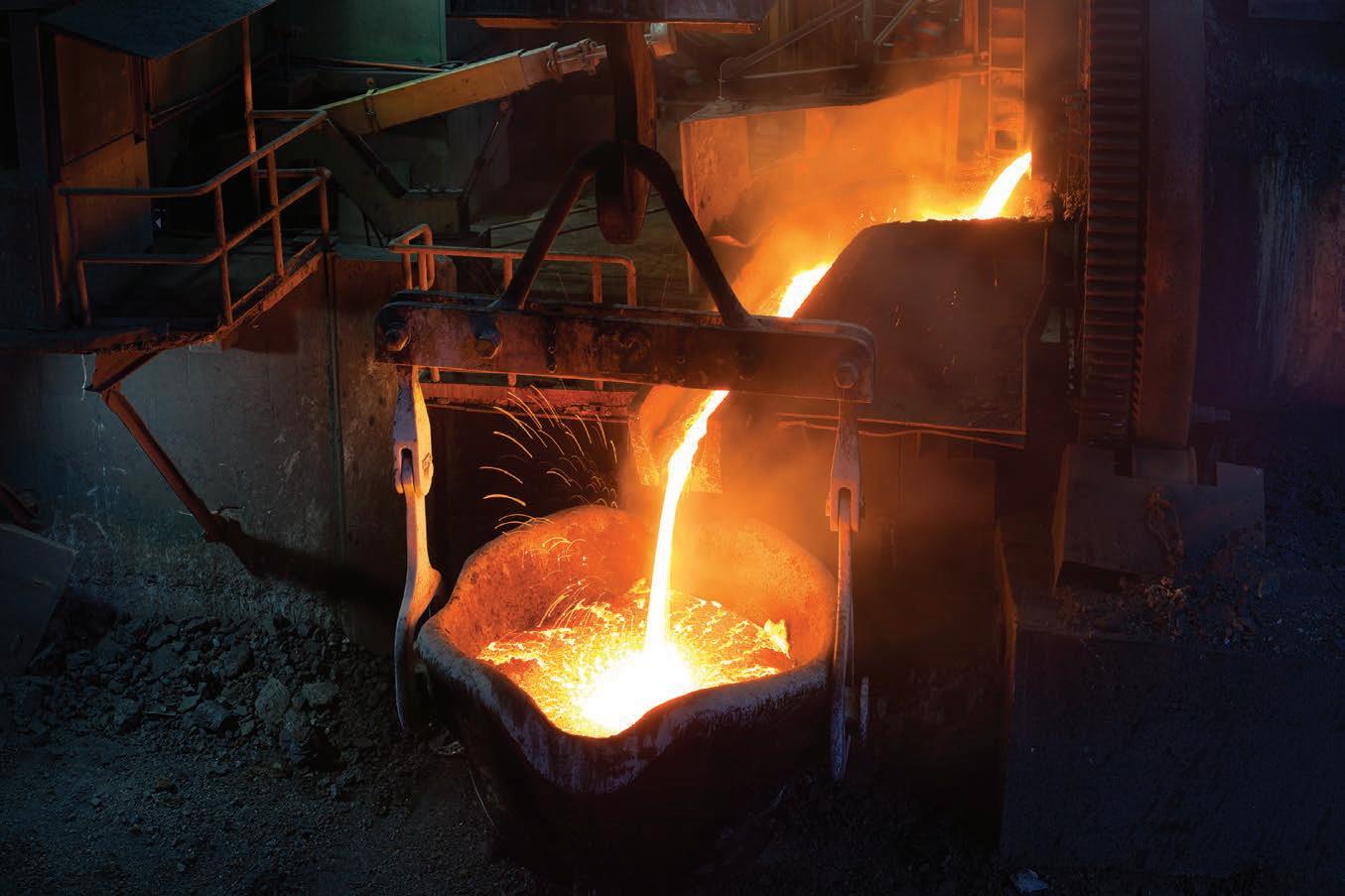
But why is there a global shortage, and will this jeopardise the West’s decarbonisation priority?
Copper was the key element for the Bronze Age (around 2000 BC to 700 BC) and arguably the first major inflection after the Agricultural Revolution (circa 10,000 BC).
It is now being relied upon for the heavy lifting in the world’s decarbonisation efforts. Demand is expected to double from 25 million tonnes today to approximately 50 million tonnes by 2035 in order to deploy the technologies critical to achieving net-zero goals by 2050.
These technologies, including electric vehicles (EV), batteries, solar panels and wind turbines, require up to 12 times more copper than their fossil-fuel counterparts.
The EV ecosystem is only expected to expand, recording approximately 11 million sales in 2022, with a three-fold growth forecast of approximately 30 million units by 2028.
The demand outlook for copper has also been affected by China’s recent plans to withdraw strict zero-COVID measures in an effort to prompt economic recovery. China already consumes 54 per cent of the world’s refined copper, and the recent spike in the country’s demand has placed upward pressure on prices.
Political unrest in South America, the backbone of global copper production, is placing further strain on supply streams.
The Americas collectively host 75 per cent of the largest copper mines, with Chile the top producer (27 per cent of global copper production), followed by Peru (10 per cent), and the Demographic Republic of Congo alongside China (8 per cent).
Recent political disarray has threatened 30 per cent of Peru’s copper supply. Multiple world-leading mines such as Glencore’s Antapaccay and MMG’s Las Bamba, which account for 2.5 per cent of global copper output, have been closed or restricted by protester roadblocks.
Similarly, Chile’s rising inflation and unemployment have contributed to an
increase in crime and protests are in favour of foreign-owned exporters, with new taxes introduced on miners.
The disruptive effect of geopolitical upheaval remains a risk for future copper supply and, due to the dependency on South America’s production, this poses a threat to countries that rely on this commodity to meet sustainability targets.
Despite the uncertainty, most shortterm growth is expected to be derived from Chile and Peru. Global mined output is still expected to grow by 7.5 per cent in 2023 before moderating to 3.7 per cent in 2024, where output will sit at more than 24 million tonnes.
Australian mining giants have been fully aware of the supply-and-demand predicament, with foresight to make acquisitions aimed at capitalising on growing copper demand.
BHP announced the completion of the OZ Minerals acquisition in May, boosting its copper production by 7 per cent, while Rio Tinto made significant investments into copper late last year, with a $2.2 billion acquisition of Turquoise Hill Resources.
While copper has played an essential role in many of the greatest green technological advancements, it isn’t deemed environmentally sustainable to mine.
And increasingly tighter climate change regulations mean there are few incentives to start copper mines.
This neglect to invest in new copper discovery means ageing mines are being exploited past their use-by date.
It would appear rational for producers to capitalise on mismatched copper supply-and-demand dynamics, presenting a compelling opportunity for investors to act on battery metal growth and the decarbonisation narrative. However output is slipping as ore quality deteriorates.
Over time, rather than new mining investments, we have utilised recycled copper inventories, which are now at record lows.
The lack of inventories, the recent global infrastructure stimulus and demand from the EV sector are further posing a threat on the drawdown of inventories and the lack of supply to restock. In response, the global recycled copper market, estimated at $US238.61 billion in 2022, is now forecast to reach $US330.83 billion by 2028.

Resources giants are now trying to secure the next generation of deposits. But even if copper producers and recyclers attempt to increase output as prices rise, there is no quick solution to ensure long-term supply.
Therefore, a perennial production risk introduced by a critical supply gap looms, which is exacerbated by a 15–20 year timeframe between discovery and production for new copper deposits.
Many major global copper producers also operate in highly regulated environments, further delaying approvals to start business.
With the assumption that mining output continues to grow at a rate of 2.69 per cent annually, global output will reach approximately 31 million tonnes by 2035, short of the 50 million tonnes we expect to be needed. The supply-and-demand gap is likely to continue widening.
This leaves increasing existing mine output and copper recycling as the main sources of additional supply.
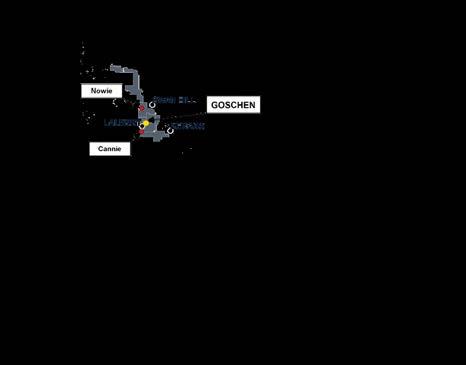
But what other solutions exist to bridge the supply gap?
The adoption of emerging technologies, including coarse particle recovery, sulphide leaching, and process optimisation with machine learning, can improve productivity, reduce inputs like water and electricity, and open new opportunities to process orebodies that wouldn’t be otherwise economical.

These technologies are particularly important in Chile and Peru, where local operations are dealing with lower ore grades, water scarcity, and a push to lower environmental footprints, while simultaneously generating economic value.
In many ways, South America is ground zero for the next stage of technology that will be used to increase production and meet future copper demand.
VHM’s advanced pre-production stage Goschen project presents an economical, high-grade mine and processing operation for producing rare earths and mineral sands in Victoria, Australia.

Goschen is positioned to supply the global economy with high-grade rare earths, ziron and titania products, and to generate jobs for the local Loddon-Mallee region.
Goschen offers an attractive A$1.5 billion NPV, EBITDAX of A$290 million annually and an IRR of 44% with a rapid payback of 2.8 years.
Goschen’s critical mineral commodities mix includes:
The economic impact of this critical supply gap is sustained inflation, placing growing price pressure on electronics and construction materials. Consequently, central banks continue to tighten monetary policy, placing a pinch on cost-of-living conditions.
The RBA’s move in May to lift the cash rate by 25 basis points – to 3.85 – in an effort to bring inflation within its target rate of 2–3 per cent is a significant by-product of ongoing commodity supply shortages.
Until resolved, the cost of materials such as computer chips, toasters and power systems
that rely on copper inputs is likely to remain high. Copper is also proving to be one of the most capital-intensive resource industries on the ASX, which is taking a significant toll on company cashflows.
While the copper shortage is a shortto-medium-term economic concern, the disequilibrium between copper supply and demand presents future opportunities for Australia.
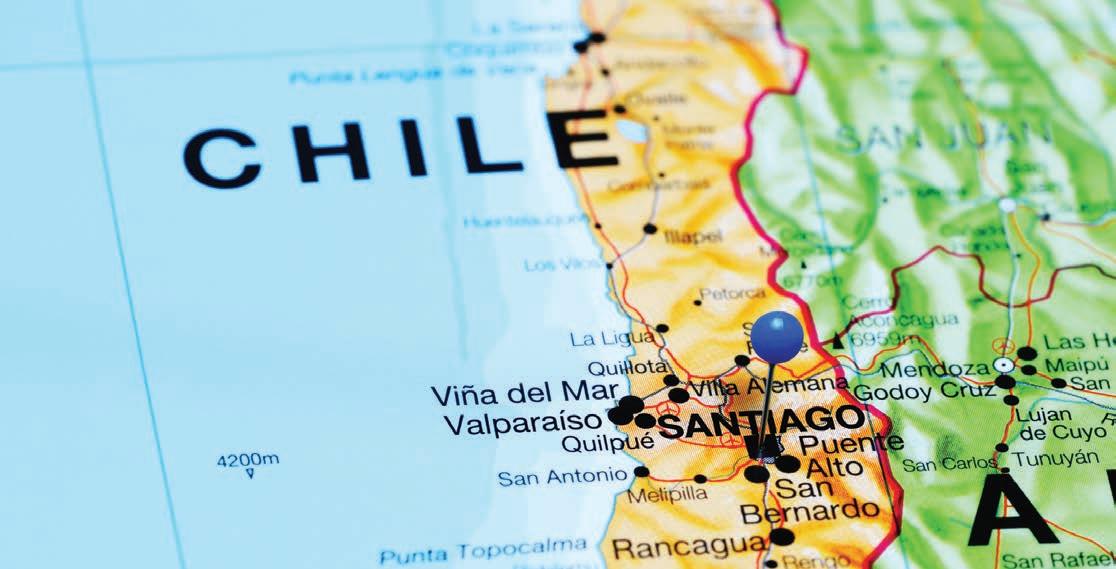
But despite this opportunity, copper is not named on the Australian Government’s list of 26 critical minerals, demonstrating a lack
of awareness regarding its role among other commodities key to the green transition.
Australia is currently the world’s sixth largest copper producer, recording $12 billion in exports in 2021–22, and houses the second largest copper reserves in the world.

Its geopolitical safety and resource potential means Australia can support global energy security and strategically place itself as a renewable energy superpower. This will enable the country to capitalise on future demand growth, increase export revenue and boost employment and economic growth.



In the face of the war in Ukraine and rampant inflation around the world, some might think it is only natural for central banks, alongside many other investors, to load up on gold.
While these factors may have figured in the minds of central bankers, their thinking towards holding gold has evolved considerably in the past two decades.

While 2022 was a historically strong year for central bank gold buying, it is the latest in a 13-year stretch of net buying by these institutions.
Central banks have long been familiar with gold as an asset class.
Through variations of historical gold standards, central banks came to accumulate large gold reserves initially to back their paper currencies. The implementation of the Bretton Woods system after WWII continued to place gold at the heart of the international monetary system.
The US dollar would be pegged to gold with guaranteed convertibility at a fixed rate, while all other currencies would be pegged to the US dollar. However, skyrocketing US budget
deficits in the subsequent decades led to a breakdown of the Bretton Woods system until the US finally suspended the convertibility of the dollar to gold in 1971, effectively ending the metal’s formal role in the international monetary system.
For several decades after the end of the Bretton Woods system, central banks found themselves managing large gold reserves despite the fact it no longer had any formal function in backing currency. This led to a sustained period of central bank gold sales, in particular from Western European central banks.
For many years, central banks were net sellers of gold and it seemed like the metal would never regain its prominent role as an international reserve asset. But the 2008 global financial crisis abruptly reversed this phenomenon, as the advent of quantitative easing by many central banks sparked fears of currency debasement and the spectre of hyperinflation.
Western European central banks ended their gold sales, as they found value in the metal as a strategic asset amid a quickly changing monetary environment. More significantly, however, central banks in
emerging markets began to accumulate large quantities of gold reserves as they saw their large US dollar holdings come under threat from quantitative easing.
In the years since the global financial crisis, attitudes towards gold has been defined by several major phenomena: Western central banks have ended sales but are unlikely to add gold; central banks in emerging markets have risen as the driving force behind new gold buying; and central banks in countries that produce gold have developed programs to add reserves through domestic production.
Among these phenomena, buying from emerging markets has largely reshaped the story of gold as a central bank reserve asset.
The central banks in Russia, China, India, Turkey, and many other larger emerging economies have added significant quantities to their reserves since 2008. Furthermore, many other emerging markets’ central banks, including Thailand, Brazil, Hungary and Poland, have made notable purchases.
These central banks started with a very low level of holding compared to their advanced-
Central banks bought more gold than ever in 2022, adding over 1100 tonnes of the yellow metal. World Gold Council’s Shaokai Fan explains why.Central banks have increased their gold-buying habits in recent years.
economy peers. The drive to diversify reserve assets from market-driven and political risks has naturally led many to choose gold.
In addition, central banks of countries like Kazakhstan, the Philippines and Mongolia have tapped domestic gold production. This can be advantageous as it allows a central bank to pay using local currency, whereas buying internationally would require exchanging a hard currency (like the US dollar) for gold.
Several factors may have driven last year’s record central bank gold-buying.
Russia’s invasion of Ukraine has re-focused attention on other global hotspots like the Taiwan Straits or the Korean peninsula.
Strong Western unity against the invasion of Ukraine has strengthened ties between Russia and China, while many non-aligned countries are precariously balancing relations between these two camps. This has prompted a wave of de-globalisation and heightened tensions.
From a central bank perspective, the rapid imposition of sanctions against the Russian foreign currency reserves was new and unexpected. While some central banks have faced sanctions before, none approached the size and importance of the Bank of Russia. The freezing of its offshore foreign currency reserves proved that the US dollar could indeed be wielded at a large scale.
The sanctions against the Russia may have prompted a re-thinking of the nature of political risk and the accessibility of a central bank’s foreign currency reserves that are domiciled overseas.
Gold, if stored domestically, is immune
from seizure. While a country facing international sanctions would have difficulty using gold for cross-border transactions, its very existence provides a level of comfort within a domestic economy and financial markets.
This may have prompted the large-scale gold buying in 2022. For example, China’s central bank reported gold purchases for the first time in several years. Large gold purchases also came from the central banks of Iraq, Egypt, Turkey, and the UAE in 2022.
Central bank investment trends can be difficult to assess. Their investment decisions are not purely based on market factors, but usually involve elements of political and strategic calculation as well.
It is therefore difficult to say whether central bank gold buying will continue, and whether it will continue at the blistering pace we witnessed in 2022. That said, the trends continued into the first quarter of 2023. China continued to report gold buying, while Singapore announced a 51-tonne gold purchase in the first two months of the year.
The reasons that drove central bank gold-buying last year persist. In fact, recent discussions have increasingly focused on the long-term role of the US dollar in the global economy and whether alternative currencies or arrangements should displace its supremacy.
Most analysts predict that the US dollar will remain the unparalleled currency of international trade for years to come, but its position will face steady erosion that may be accelerated by the weaponisation of the dollar in recent years.
What this may mean for gold as a reserve asset is still unclear; however, the central bank of Hungary may have provided some insights.
After a substantial gold purchase in 2019, the Hungarian central bank took the rare step of detailing its rationale, suggesting it added gold because it foresaw disruption during a period of transition in the international monetary system, highlighting gold’s role as a risk-mitigator.
With so much uncertainty clouding the global outlook, perhaps gold can still shine as a beacon of stability.

Shaokai Fan is the head of Asia-Pacific (exChina) and global head of central banks at the World Gold Council, where he is responsible for advising governments on gold matters and enhancing the gold market through dialogue and thought leadership. He works directly with central banks and sovereign wealth funds on strategic investment considerations, including engagements with senior officials and policymakers on the intersection of geopolitics and finance.
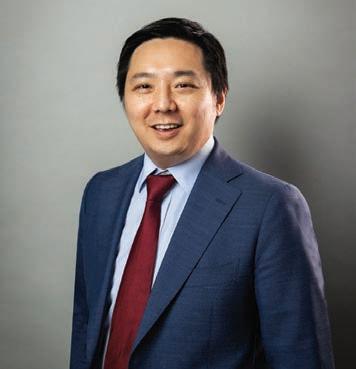
Being a technology frontrunner can be a difficult task, with no reference points to draw inspiration from apart from the internal belief of a dedicated research and development (R&D) team.
What if your new idea or premise is misdirected? What if the pioneering solution is good in theory but lacks precision on the ground?
Epiroc is used to driving new innovations in the mining industry and carries out its foundational tasks with full belief that even if a product isn’t what it needs to be right away it will get there through pilot testing and practical development.
For this, the Swedish original equipment manufacturer (OEM) works closely with its customers to workshop and refine a solution to the point that it not only supports a mining operation but thrives in its new environment.
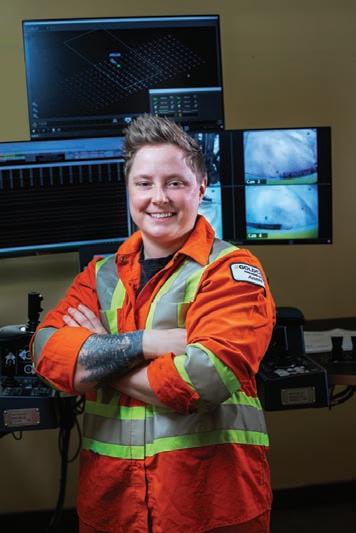
This is the story of Epiroc’s autonomous SmartROC D65 surface drill rig.

Now in its second generation, the SmartROC D65 has become one of the premier autonomous solutions on the mining market, demonstrating the essence of automation and how it can lead to improved safety, higher drilling efficiency, more accurate drilling and increased productivity overall.
And Epiroc has not settled with a good thing, continually evolving the product to realise further gains and possibilities as technology and the mining industry itself has evolved.
Epiroc Australia automation product specialist Scott Worthington explained the evolution of the SmartROC D65.
“The navigation and obstacle detection algorithms developed on the Pit Viper provided a solid foundation for the D65, and we had years of data collection and information to support those,” he told Australian Resources & Investment. “So that wasn’t too difficult to bring across to the D65 platform.
“The biggest improvements we’ve made on this machine are around drilling efficiency, while the drill bit is actually contacting the ground. We’ve made massive improvements in the auto-drill and anti-jam algorithms.
“The drill has to follow certain parameters when drilling and we’ve established a bunch of algorithms so that it has more tools at its disposal to react and change its output depending on the ground conditions.
“It can adjust its own values and parameters and alter the feed pressure, turn
the air up and down, on and off and retract the bit and get itself out in what we call anti jamming.”
Worthington said it’s inevitable that a drill will get bogged.
“We’re not magicians,” he said, “and we can’t change the grounds that we’re drilling in.”
Epiroc’s eagerness to collaborate with its mining partners has supported the constant improvement of the autonomous SmartROC D65 surface drill rig.
But Epiroc can change the rig’s response to a situation, and while previous models of the SmartROC D65 would stop when getting bogged, the SmartROC D65 MKII (the latest model) has learned how to get itself out.
It’s a smarter system that can achieve more on its own without human intervention. This not only leads to a safer, more productive, accurate and efficient drilling operation but also generates further value downstream in fragmentation, hauling and crushing.
The latest iteration of the autonomous SmartROC D65 MKII has been developed for production drilling applications. This will be released in June this year and see Epiroc take its customers into new drilling territory.
“Many of our mining partners who currently utilise one or more of our over 95 full autonomous Pit Viper drills also operate D65 drills,” Epiroc automation manager –surface mining Chris Blignaut told Australian Resources & Investment.

“This market is likely ready for an autonomous D65 solution, and we are eager to introduce it to them. But we are looking to support all our business partners in implementation of autonomous technology through project-based activities, which are executed by the Epiroc customer centre teams.”
To support the roll-out of the autonomous SmartROC D65 MKII for production drilling, Epiroc will do what it does best: actively
engage and collaborate with its partners to ensure the product meets the precise requirements of a mining operation.

This will not only lead to the development of bespoke solutions specific to a customer but also enable the continued improvement of the SmartROC D65 MKII.
Blignaut said Epiroc will then be looking at taking this fully autonomous solution into pre-split and contour applications.
And Epiroc won’t stop until it has achieved universal applicability across a surface drilling operation.
“We will continue our current journey with our partners to develop and trial the autonomous system in pre-split and contour drilling, with the eventual goal of enabling the drill to operate autonomously under any application.”
The quality and applicability of Epiroc’s products not only boils down to the OEM’s transparency to collaborate with mining companies to hone their products, many of which are Tier-1 miners, but also the company’s esteemed R&D division.
It takes smarts and a strong company culture to innovate inspired new solutions and Epiroc leans on its 6th Sense model to inspire its R&D work.
This has supported the continued evolution of the autonomous SmartROC D65.
“Ongoing development is a highly data-driven process, where we analyse the vast amounts of data coming from the
autonomous drill to investigate where to optimise,” Blignaut said.
“This is part of the Epiroc 6th Sense model. When the data points us towards an opportunity, we create a closed feedback loop between operation of the drill and product development.
“This requires a close and collaborative partnership with our customers, and a unique style of agile software development. Getting this right is crucial to the success of the continuous improvement that this technology needs.”
6th Sense also assists Epiroc’s partners with condition monitoring, where operators can leverage data-led insights to specifically understand how their drills and drilling tools are performing at any given time.
Through 6th Sense products, the SmartROC will drill at the right speed at the right time and know exactly when it’s time to change tools to prevent a failure and potential downtime.
The evolution of the autonomous SmartROC D65 drill rig is a representation of Epiroc’s constant pursuit of improvement and commitment to doing right by its partners.
The fact that customers play a key role in the development of Epiroc’s products represents everything that’s great about today’s mining industry – transparency and a united approach to creating the safest and most efficient machines possible.

Keep up to date with the latest executive movements across the resources sector, featuring BHP, South32 and Chalice Mining.
Having only joined OZ Minerals in March 2022, Michelle Ash is joining BHP to oversee the company’s copper assets in South Australia.
Here she will report to BHP chief operating officer Edgar Basto.
“The team will work closely with the Olympic Dam, Carrapateena and Prominent Hill teams to develop the growth projects and infrastructure required to build a copper province in South Australia,” Basto wrote to staff in an internal note seen by the Australian Financial Review.
Ash joined OZ Minerals as a technology executive, where she oversaw information and communication technologies (ICT) at the company.
It is also understood that OZ Minerals integration executive Claire Parkinson will be joining BHP to support the cultural integration of OZ Minerals.
“Claire will place a pivotal role to ensure the core elements of the OZ Way are considered, represented and personified through our integration program,” Basto said.
OZ Minerals chief Andrew Cole won’t be joining Ash and Parkinson to BHP, deciding instead to take a break before he considers his next role.
Len Jubber recently resigned as chief executive officer (CEO) of potash miner Kalium Lakes after joining the company in December 2021.
The Kalium Lakes board honoured Jubber’s contribution to the company but refrained from providing any more detail on his resignation.
The company’s general manager operations Jason Morin has been appointed as acting CEO in Jubber’s place, having established a strong understanding of Kalium Lakes’ culture, strategy, markets and customers since taking on the general manager role in August 2022.
Prior to joining Kalium Lakes, Morin was Alcoa’s WA manager of mines and before that he was general manager operations at St Barbara where he was instrumental in the development of the Leonora gold operations.
“Jason is an exceptional leader and combined with his extensive and detailed experience across Kalium Lakes’ operations, risk management and corporate functions, he is the ideal person to lead the company,” Kalium Lakes non-executive chair Cheryl Edwardes said.
“It is pleasing to have appointed an internal successor which demonstrates the talent within the leadership team.”
Chalice Mining recently made a series of changes to its executive leadership team, including long-serving chief financial officer (CFO) Richard Hacker moving into the newly-created role of general manager (GM) –strategy and commercial.
This will see Hacker lead strategic partnership opportunities for the Julimar nickel-copper-platinum group elements (PGEs) project in WA.
Chris MacKinnon, who has been Chalice’s business development and legal manager since 2020, will take over from Hacker as Chalice CFO.
“As Chalice continues to grow and develop as an organisation, we are pleased to announce this important strengthening of our executive leadership team,” Chalice managing director and chief executive officer Alex Dorsch said.
“Richard has played an instrumental role in the company’s success since its foundation, and I am looking forward to deploying his strong commercial and corporate skills in the newly-created position of GM – strategy and commercial.”
Dorsch said MacKinnon has been an “excellent recent addition” to Chalice and is ideally qualified to succeed Hacker as CFO.
Pilbara Minerals continues to add new members to its team, with Luke Bortoli recently appointed as CFO.
It comes after the lithium miner added a project director, chief development officer and chief sustainability officer in recent months.
Bortoli most recently served as CFO of Afterpay where he oversaw a period of rapid growth for the successful buy now, pay later company. He has also held various roles at Aristocrat Leisure in the past.
“Luke has an exceptional track record of value creation as a senior executive helping fast-growth companies scale operationally to maximise their potential,” Pilbara Minerals CEO and managing director Dale Henderson said.
“Luke is passionate about futurefacing industries and has a track record of stewarding the finance needs of companies in a rapid stage of evolution. He has deep experience in scaling the people, processes and systems that are required to support growth.
“Luke’s demonstrated ability to balance commercial and financial discipline, strong governance and innovation will place him in good stead as he takes on this role.”
Liontown Resources has appointed Jon Latto as its new CFO, having served
in the role in an interim capacity since December 2022.
Latto has spent more than 15 years’ as a CFO for ASX-listed resources companies, and was most recently CFO for mid-tier gold producer Regis Resources.
“I am delighted to confirm Jon’s appointment as our CFO and am pleased we can continue to benefit from his extensive expertise as we drive the rapid development of the Kathleen Valley lithium project towards production in mid-2024,” Liontown CEO and managing director Tony Ottaviano said.
“Since he joined Liontown, Jon has made a significant contribution to the finance function, executive team and the board, building on his deep knowledge of financial management and broad experience in the resources sector.
“I look forward to working closely with Jon as we continue to transition Liontown Resources into a globally significant provider of battery minerals.”
South32 recently appointed Jane Nelson and Carlos Mesquita as independent nonexecutive directors, coinciding with the resignation of Guy Lansdown.

Nelson brings extensive environmental, social and governance (ESG) skills and leadership to South32, having been focused
on sustainable development and natural resources for more than 30 years. This includes being the founding director of the Harvard Kennedy School’s Corporate Responsibility Initiative.
“Jane brings extensive experience in the sustainable development of natural resources, which will enhance the board’s broad range of skills and experience,” South32 chair Karen Wood said.
“Her appointment will support the group’s consistent focus on sustainably producing commodities that are critical in a low-carbon world and the creation of enduring social, environmental and economic value.’’
Mesquita has more than 40 years’ experience in the mining sector and has spent much of his career focused on base metals and aluminium in the Americas and Africa. This included being asset president of BHP’s Escondida copper mine in Chile and Mozal Aluminium in Mozambique.
Mesquita worked with South32 on its recent acquisition of a 45 per cent stake in the Sierra Gorda copper mine in Chile.
Lansdown has resigned from the South32 board to focus on family and his charity efforts, where he is president and director of two charities that provide opportunities for disadvantaged youth in Mexico.
Inaugurated in 1958, the World Mining Congress (WMC) is the leading international forum for the global mining and resources sectors.
WMC 2023 is a unique opportunity for international representatives of the world’s leading resource economies to meet, find new partners, discuss current challenges, and share the latest research, technology, and best practice.
WMC events have set the scene for international agreements and high-level discussions that have influenced mining practices and the resource industry for decades.
Join senior mining industry owners, investors, national and international government representatives, researchers, educators, regulators, suppliers and operators from around the world in Brisbane for this opportunity to demonstrate real leadership and presence on a world stage.
• wmc2023.org
Diggers & Dealers combines 70 corporate presentations by listed mining and exploration companies with a large exhibition housing more than 150 exhibitors from the sector. Delegates include miners, explorers, brokers, bankers, investors, financiers and mining service companies from around the world. The event provides a unique opportunity for industry professionals to meet and network, visit regional mine sites, engage with media, raise finance, invest in projects and engage with the resources sector at an executive level.
An entertainment program ensures that delegates experience the best of the style and hospitality of Kalgoorlie, the unofficial gold mining capital of Australia.
• diggersndealers.com.au
Learn everything you need to know about gold investment at the 2023 Australian Gold Conference.
Australia has a long and strong association with gold and silver dating back to discoveries in various states in 1847, 1851 and 1885. Each year the conference brings together the industry under one roof to showcase not only the importance of this sector to the economy but to also profile the different ways individuals and companies can invest in the sector.
The 12th annual Australian Gold Conference will bring together all aspects of the precious metals industry to promote the sector
with keynote presentations from educators and companies showcasing their investment opportunities. The precious metals industry is a vital part of the Australian economy and this two-day event is where gold, silver and their associated sectors take centre stage.
• goldevents.com.au/events/australian-gold-conference
IMARC is returning to Sydney from October 31–November 2, after celebrating its first in-person event in three years in late 2022.
A vivid showcase of all the elements that make the mining industry great, IMARC is where the most influential people in the sector come together to share ideas and inspiration, with groundbreaking technology and world-class content on display. Learn from more than 450 mining leaders and resource experts throughout six concurrent conferences with a program covering the entire mining value chain.
The likes of BHP, Newcrest Mining, Agnico Eagle and OZ Minerals presented at the 2022 event, along with original equipment manufacturers such as Caterpillar, Epiroc and FLSmidth, so expect another slate of world-class presenters for 2023.

• imarcglobal.com
Taking place in Brisbane in 2023, the Australian Mining Prospect Awards are a great opportunity to recognise and acknowledge the people and companies in the mining sector for their outstanding work.
Having recently celebrated the 2022 Prospect Awards winners, nominations are now open for 2023, with awards honouring categories such as Indigenous and Community Engagement, Mine Project Success of the Year, Outstanding Mine Performance, Sustainability Project of the Year, Discovery of the Year and more.
Some of the 2022 award winners included Kestrel Coal for Australian Mine of the Year, Roy Hill for Mine Project Success of the Year, and Flexco Australia for Excellence in IIOT Application. This year, the awards will return to Brisbane in appreciation of the vibrancy and importance of the state’s thriving mining sector.
• prospectawards.com.au



